

Kek Lok Si Temple 極樂寺
 Go Back - Latest PENANG Sights/Streets/New Properties > Malaysia > World | Hokkien : Lessons : Dictionary | YouTube | Facebook | About Me : Contact Me
Go Back - Latest PENANG Sights/Streets/New Properties > Malaysia > World | Hokkien : Lessons : Dictionary | YouTube | Facebook | About Me : Contact Me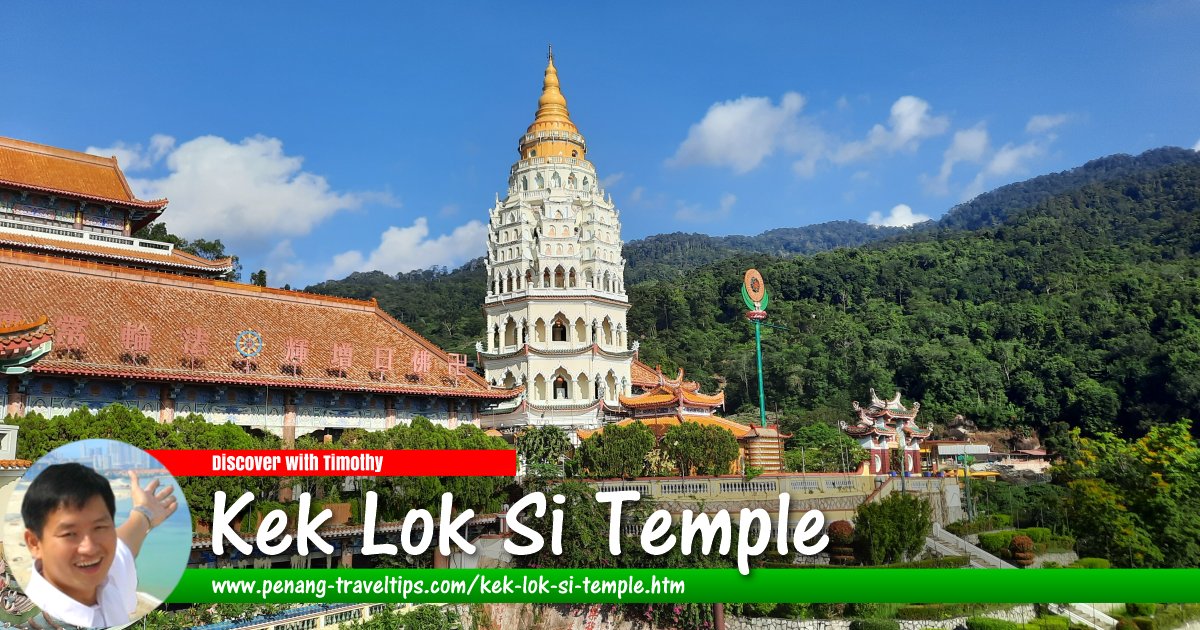 Kek Lok Si Temple, Penang (31 August 2022)
Kek Lok Si Temple, Penang (31 August 2022)
Kek Lok Si (GPS: 5.40022, 100.27384; Traditional Chinese: 極樂寺, Simplified Chinese: 极乐寺, Penang Hokkien: Kek1 Lok3 Si33
 , Pinyin: Jí Lè Sì) is the largest and arguably the best known Chinese temple in Penang. Its name in Penang Hokkien means "Temple of the Supreme Bliss".
, Pinyin: Jí Lè Sì) is the largest and arguably the best known Chinese temple in Penang. Its name in Penang Hokkien means "Temple of the Supreme Bliss".
 Discover with Timothy Videos
Discover with Timothy Videos
Visiting Kek Lok Si Temple
Due to its massive size, Kek Lok Si Temple is divided into three tiers: Lower Tier, Middle Tier and Upper Tier. The information here is correct as of 1 September 2022. An inclined lift system connects the Lower Tier to the Middle Tier and another inclined lift connects the Middle Tier to the Upper Tier. A return ticket for taking the inclined lift is RM16 per person (the same fare for Malaysians, senior citizens and foreigners). The nett proceeds from the sale of tickets go to the temple building fund.The Lower Tier of Kek Lok Si
The Lower Tier is home to the Tortoise Pond. It also has the largest car park space and also parking space for buses. This is now the new main entrance to Kek Lok Si Temple, until such time that renovation works are completed to reconnect the souvenir passageway to the temple.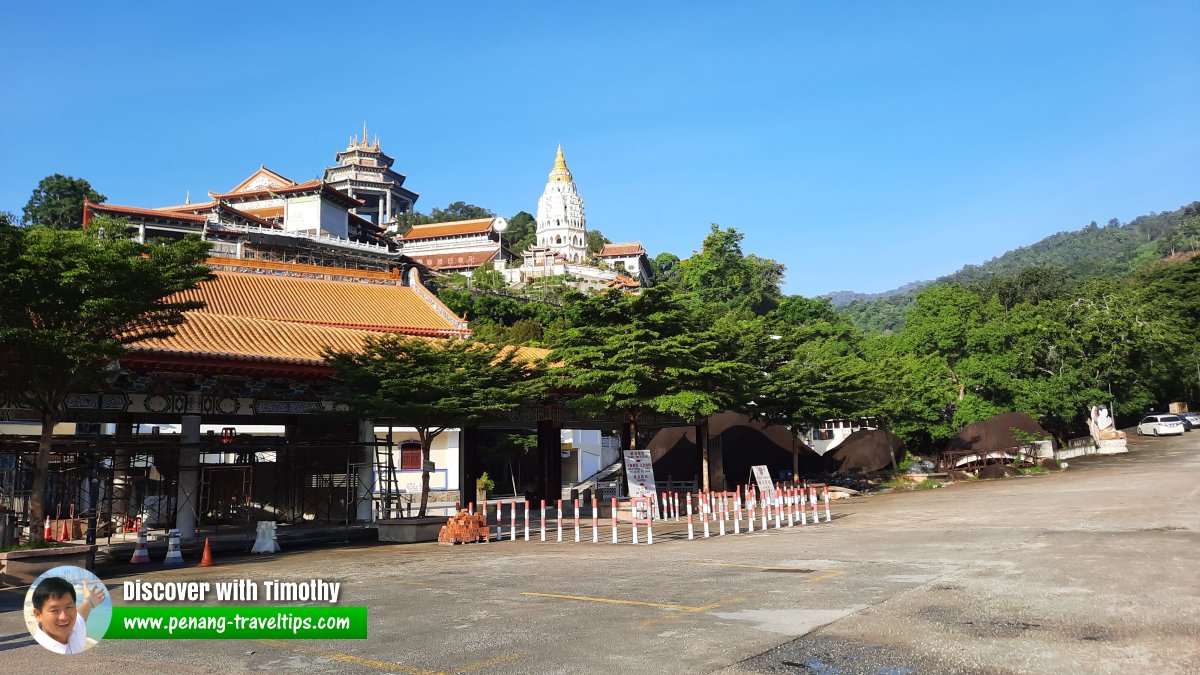 This is the Lower Tier of Kek Lok Si Temple. As of 31 August 2022, construction and renovation are still in progress. (31 August 2022)
This is the Lower Tier of Kek Lok Si Temple. As of 31 August 2022, construction and renovation are still in progress. (31 August 2022)
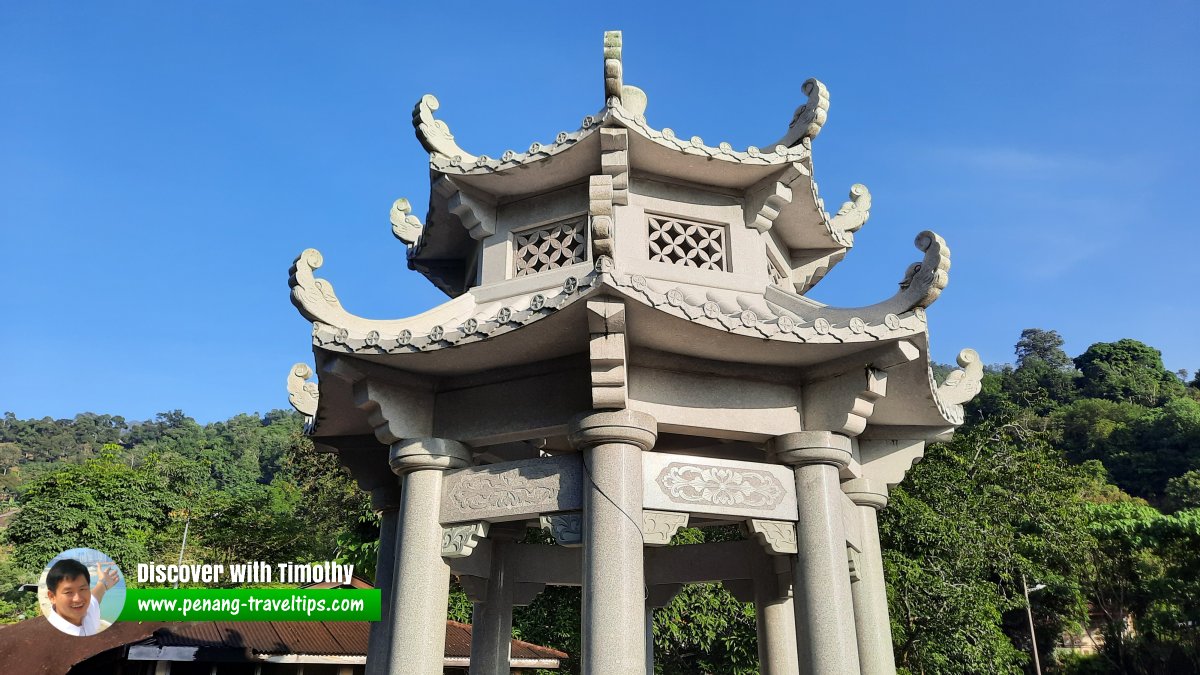 One of the granite pavilions at the Tortoise Pond, at the Lower Tier. (31 August 2022)
One of the granite pavilions at the Tortoise Pond, at the Lower Tier. (31 August 2022)
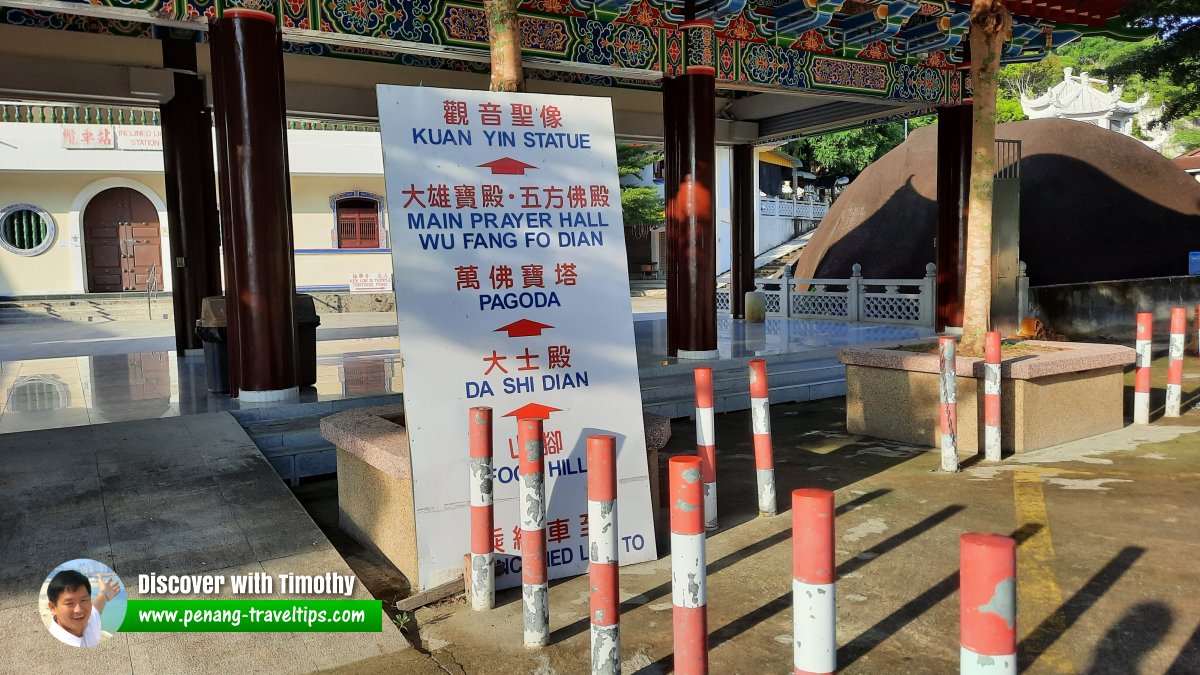 Signage at Lower Tier points to various highlights. In the background is the Lower Tier Inclined Lift Station. (31 August 2022)
Signage at Lower Tier points to various highlights. In the background is the Lower Tier Inclined Lift Station. (31 August 2022)
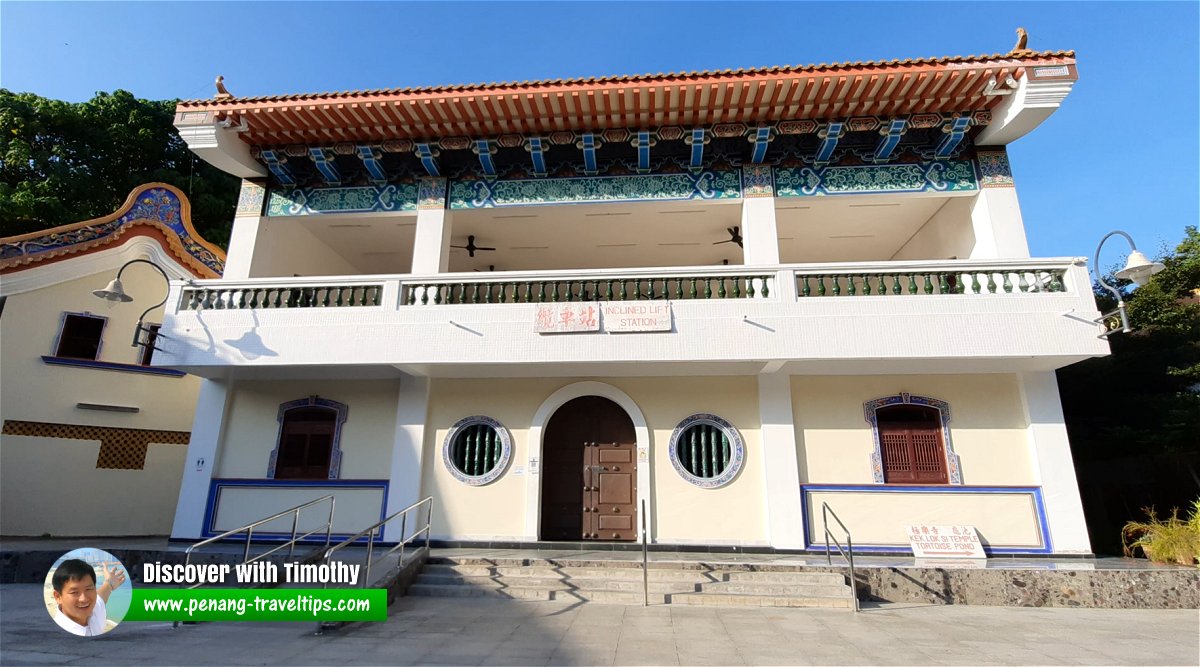 The Lower Tier Inclined Lift Station. (31 August 2022)
The Lower Tier Inclined Lift Station. (31 August 2022)
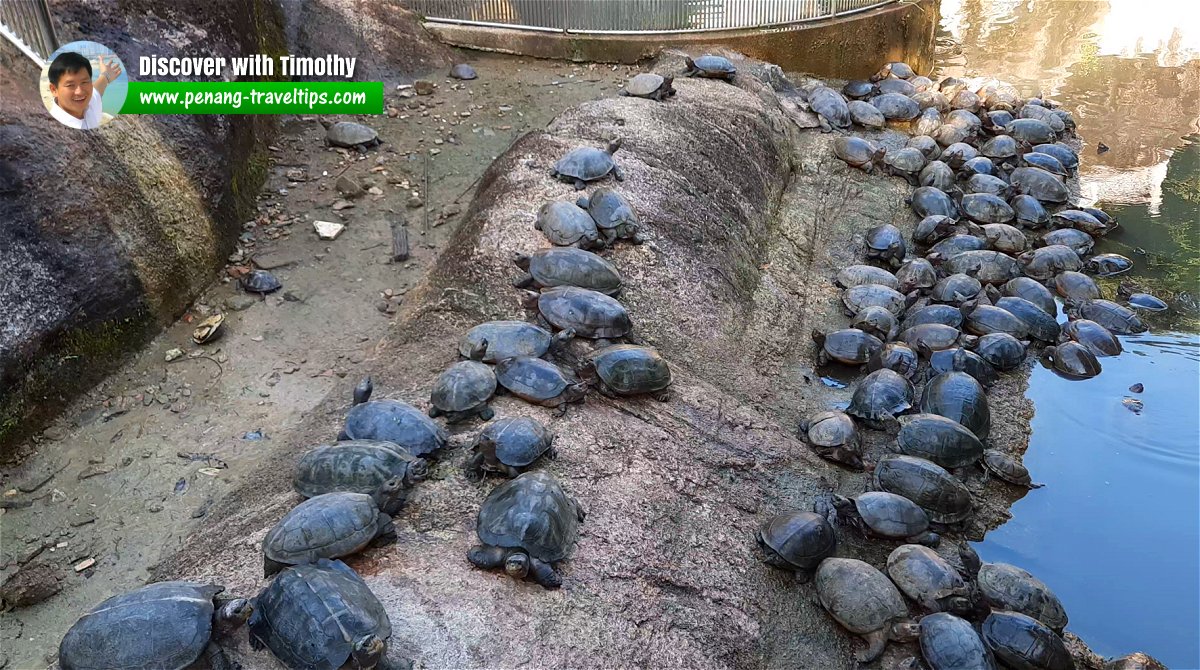 The tortoises at the Tortoise Pond at the Lower Tier. (31 August 2022)
The tortoises at the Tortoise Pond at the Lower Tier. (31 August 2022)
The Middle Tier of Kek Lok Si
The Middle Tier is the oldest and main section of Kek Lok Si. This is where the prayer halls are clustered. This is also the location of the iconic Pagoda of Ten Thousand Buddhas.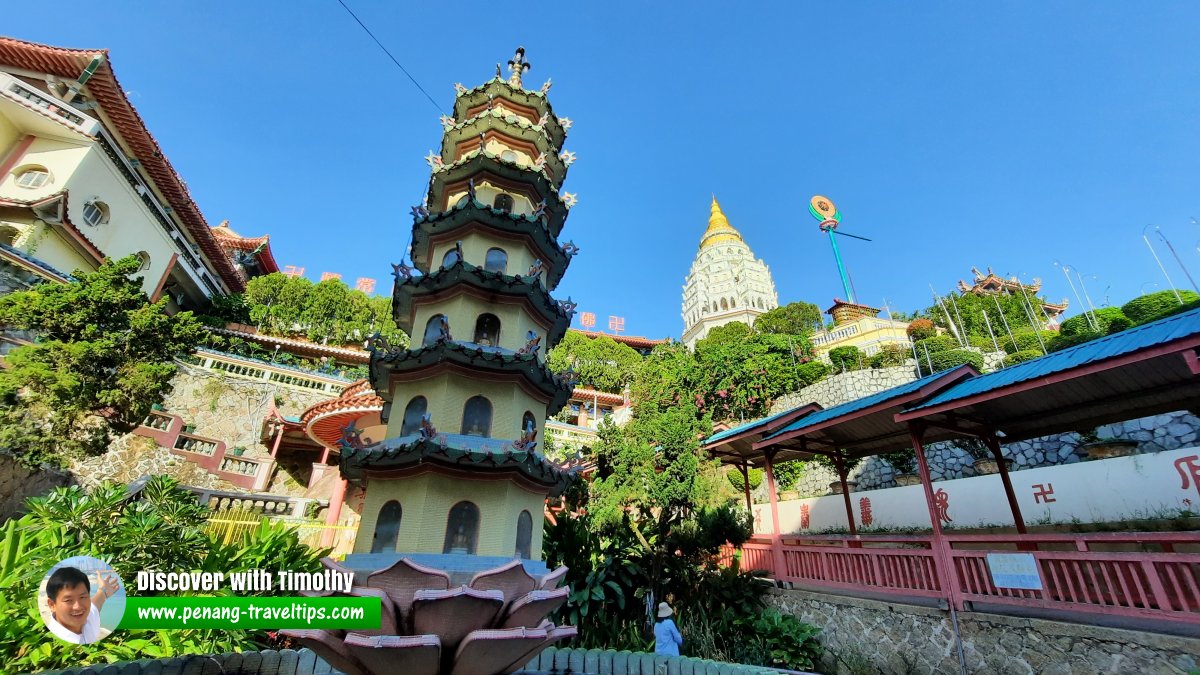 The Garden Pavilion of Lord Buddha. (31 August 2022)
The Garden Pavilion of Lord Buddha. (31 August 2022)
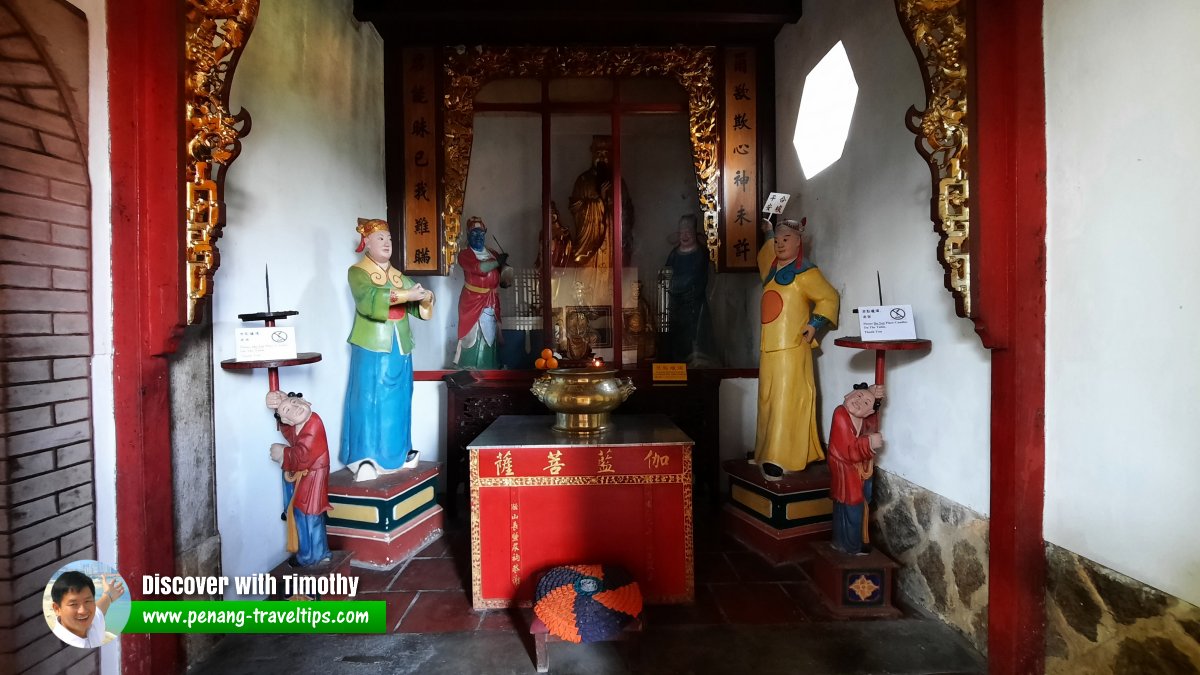 Hall of the Guardian Spirits of the monastery. (31 August 2022)
Hall of the Guardian Spirits of the monastery. (31 August 2022)
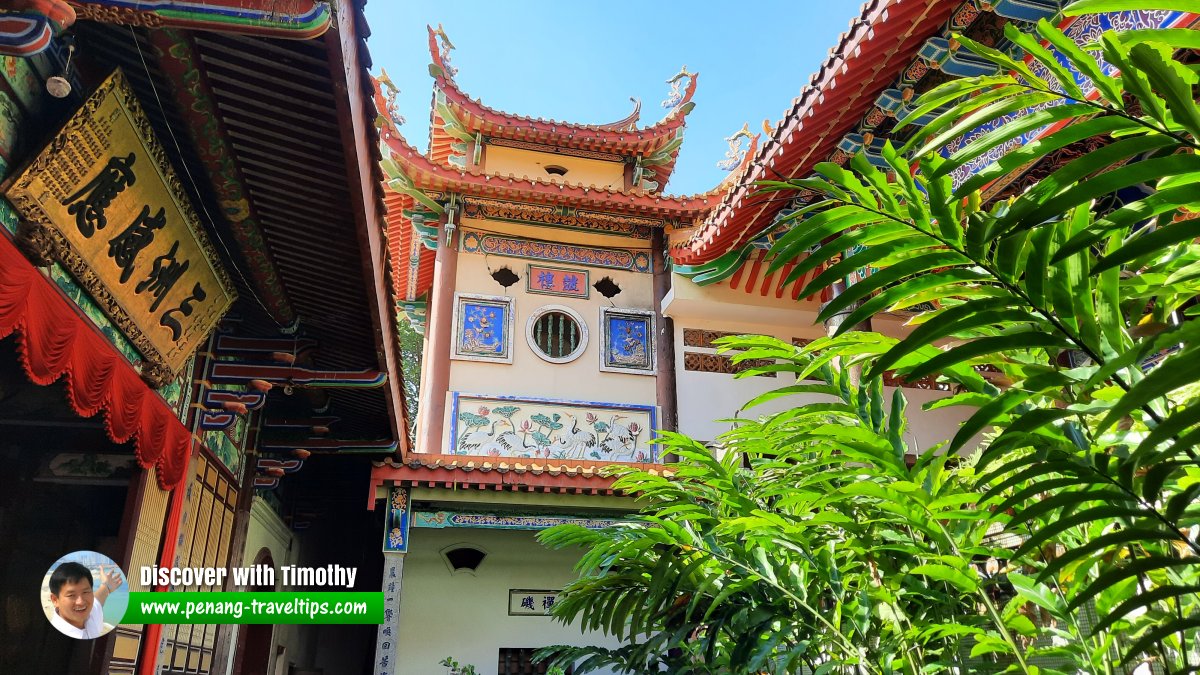 The Drum Tower of Kek Lok Si. (31 August 2022)
The Drum Tower of Kek Lok Si. (31 August 2022)
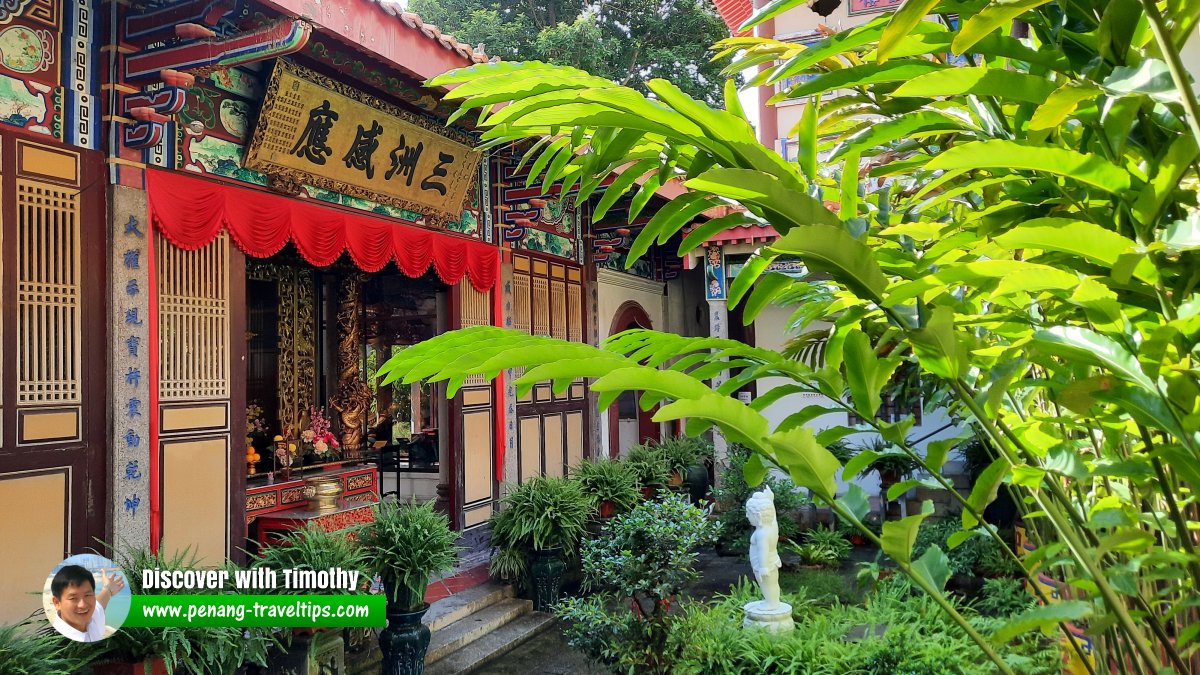 The Hall of Devas, Kek Lok Si. (31 August 2022)
The Hall of Devas, Kek Lok Si. (31 August 2022)
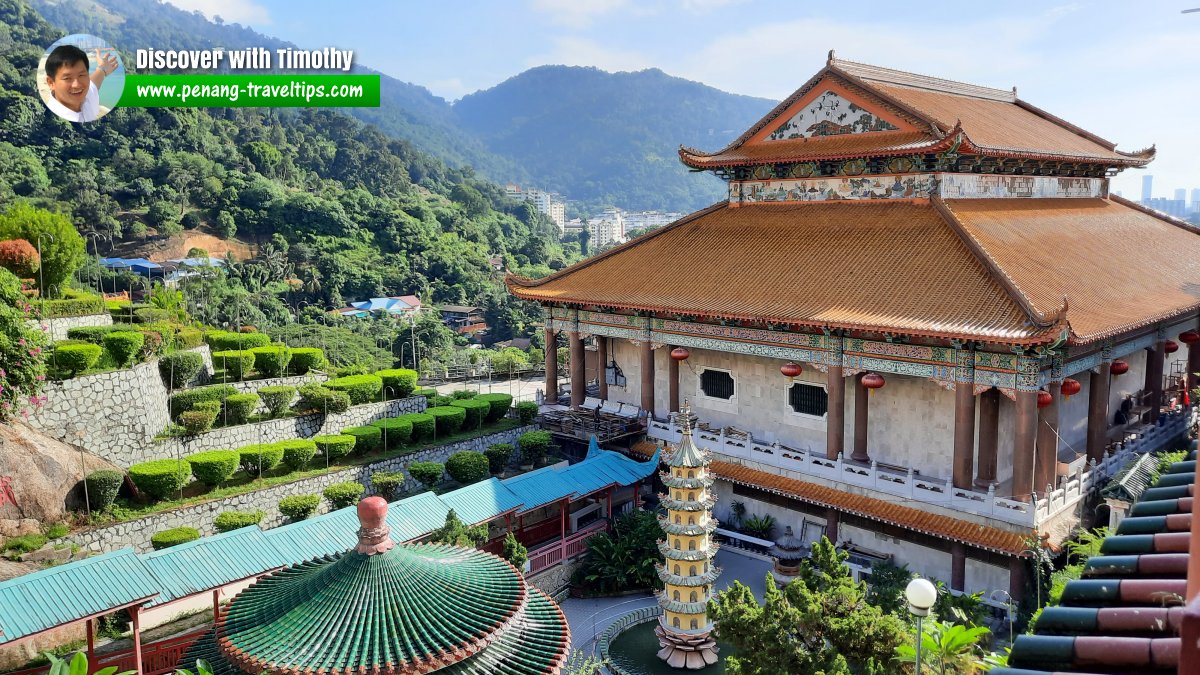 The Hall of Bodhisattvas. (31 August 2022)
The Hall of Bodhisattvas. (31 August 2022)
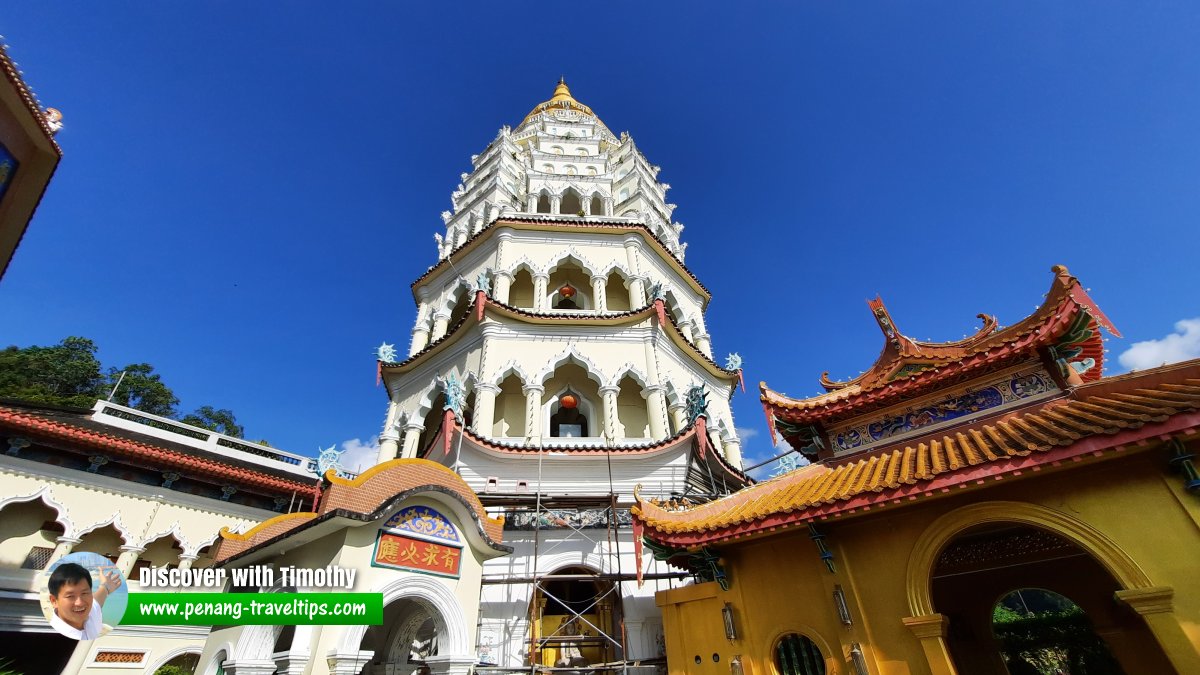 The Pagoda of Ten Thousand Buddhas. (31 August 2022)
The Pagoda of Ten Thousand Buddhas. (31 August 2022)
The Upper Tier of Kek Lok Si
The Upper Tier has the Statue of Kuan Yin Bodhisattva.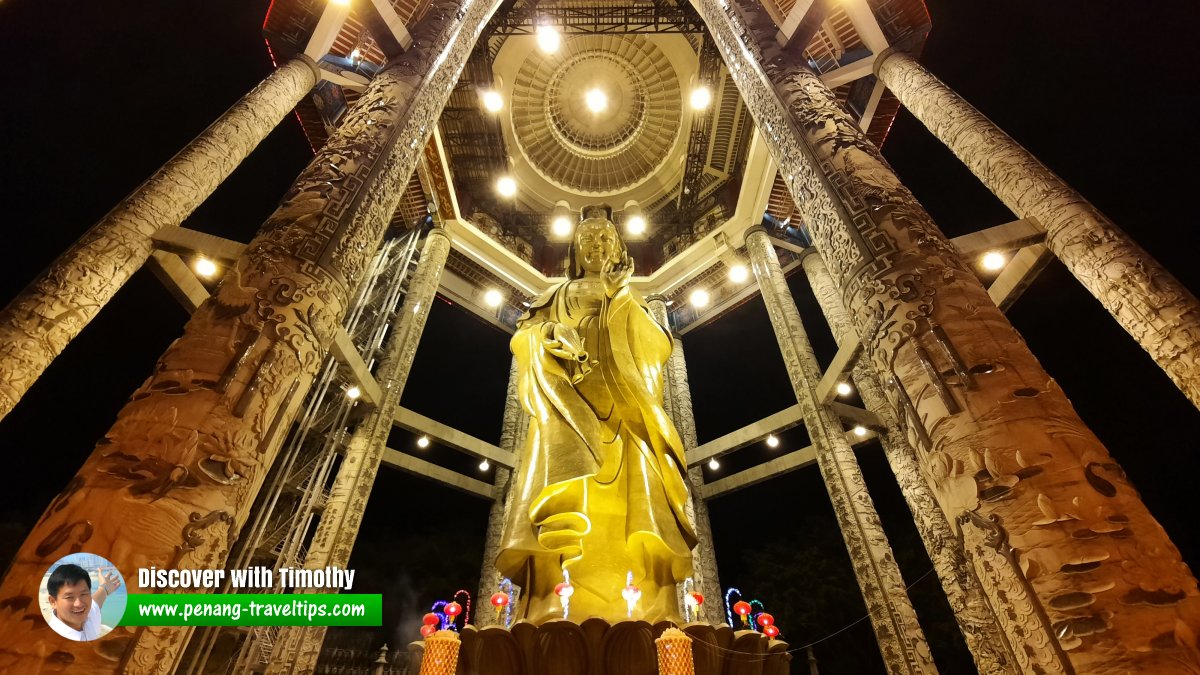 Statue of Kuan Yin Bodhisattva. (31 August 2022)
Statue of Kuan Yin Bodhisattva. (31 August 2022)
About Kek Lok Si Temple
Kek Lok Si straddles a hillside overlooking Air Itam Village on the central part of Penang Island. Kek Lok Si brings together a blend of Mahayana Buddhism with Taoist beliefs and other Chinese rituals and folk beliefs. Since the old days, the hills of Ayer Itam are regarded as important geomantically. Known as He San, or Crane Hill, they are recommended as a retreat for Taoist practitioners striving for immortality.Construction of Kek Lok Si began in the late 19th century, and has continued unabated for over a hundred years. The initial project was mooted by the chief monk of the Kuan Im Teng, Goddess of Mercy Temple of Pitt Street, the Venerable Beow Lean. Born in Fujian Province, China, in 1844, Beow Lean had arrived in Penang in 1885 with the purpose of raising funds for a monastery in Fuzhou. Instead he ended up being offered the position of chief monk-in-residence of the Kuan Im Teng by its trustees.
With the support of the consular representative of China in Penang, the project received the sanction of the Manchu Emperor Guangxu (also called Jingdi, 1875-1908, of the Qing Dynasty) who bestowed a tablet and gift of 70,000 volumes of the Imperial Edition of the Buddhist Sutras.
Funds to get the Kek Lok Si project realised came from the local Chinese people, in particular five wealthy benefactors namely Cheong Fatt Tze (of Cheong Fatt Tze Mansion), Zhang Yunan, Cheah Choon Seng, Chung Keng Kwee (the Kapitan Cina who owned Hai Kee Chan) and Tye Kee Yoon. In recognition of their contribution, the temple made them the Five Principal Directors of Kek Lok Si. Sculptures of these five main benefactors as well as other principal donors were kept in the Hall of Manuscripts to commemorate their generosity.
The original 10-acre site of Kek Lok Si was purchased in 1893. It encompasses the submit of a knoll known as He Shan. The original temple, built at a cost of $180,000 Straits Dollars, was completed in 1904. An official opening ceremony was conducted on 13 January, 1905. Although large during its time, the original complex was a shadow of greater things to come.
For the first thirty-five years of its existence, Kek Lok Si Temple was without its iconic pagoda. Nevertheless it was already assuming a position as one of the most prestigious and renowned Mahayana Buddhist religious institution in Southeast Asia.
The iconic Pagoda of Ten Thousand Buddhas was only constructed in 1927. It became an icon of Kek Lok Si Temple, and remains today as one of the most recognisable landmarks of Penang.
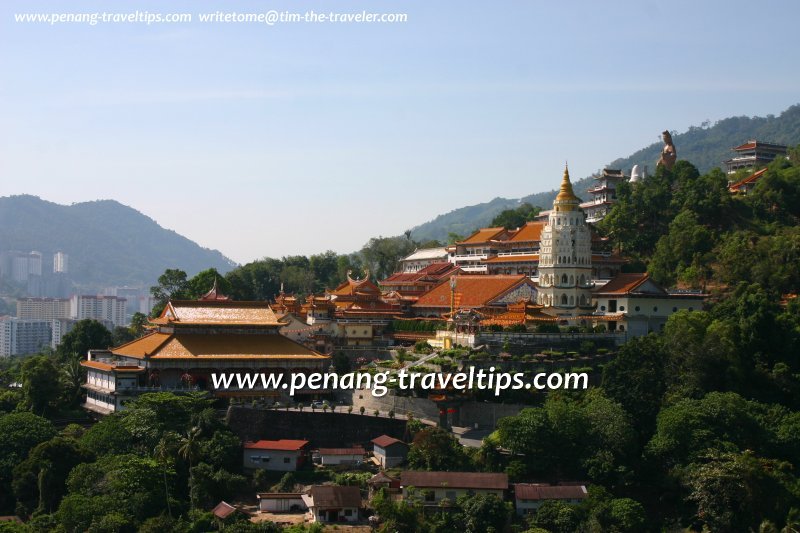 Kek Lok Si Complex (28 January 2006)
Kek Lok Si Complex (28 January 2006)
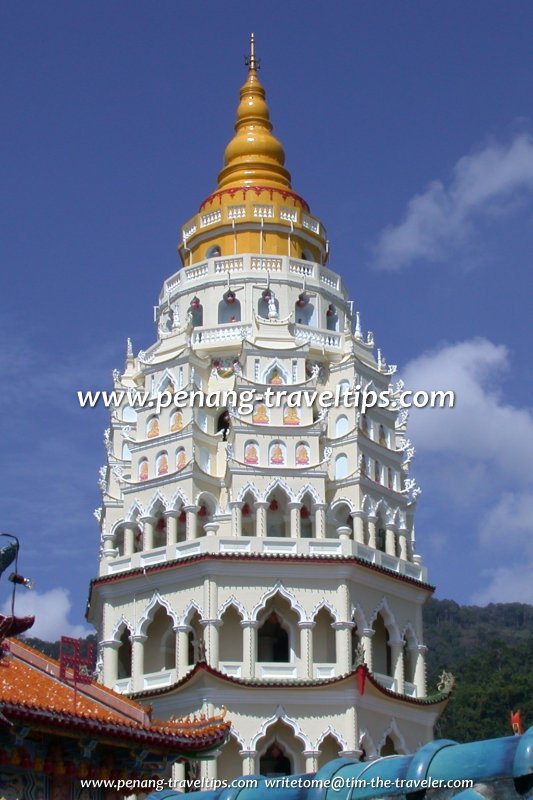 Pagoda of Ten Thousand Buddhas, Kek Lok Si (2 February 2003)
Pagoda of Ten Thousand Buddhas, Kek Lok Si (2 February 2003)
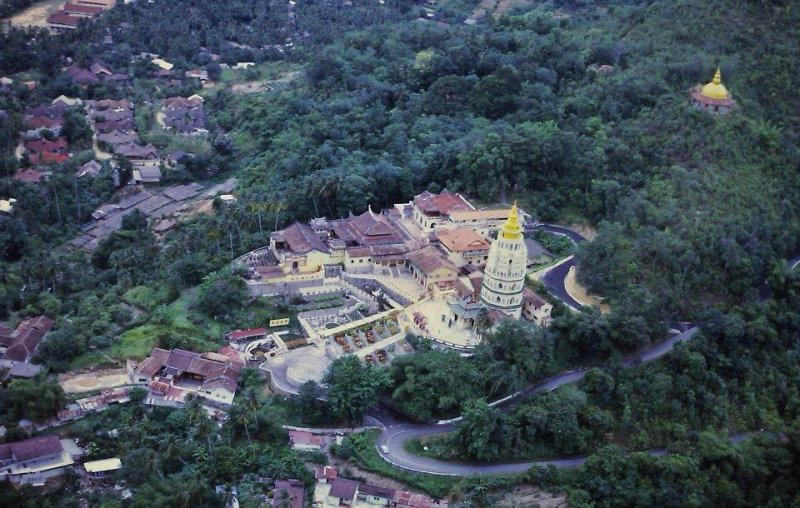 Aerial view of Kek Lok Si Temple in 1975
Aerial view of Kek Lok Si Temple in 1975© Ivan Murray
The above photo, taken by Mr Ivan Murray from a helicopter in 1975, shows the Kek Lok Si Temple before the recent phase of constructions began.
Construction of the Pagoda of Ten Thousand Buddhas began in 1915 under the second abbot of Kek Lok Si, Ben Zhong, who was also instrumented in founding the Kuan Yin See. The official name of the pagoda is the Pagoda of Rama VI. This is because the Thai monarch laid the foundation stone. Generally, however, it is better known as the Pagoda of Ten Thousand Buddhas, or in Hokkien, Ban Po That. The unusual pagoda combines a Chinese octagonal base with a middle tier of Thai design, and a Burmese crown, effectively fusing Mahayana and Theravada Buddhism symbols into one structure.
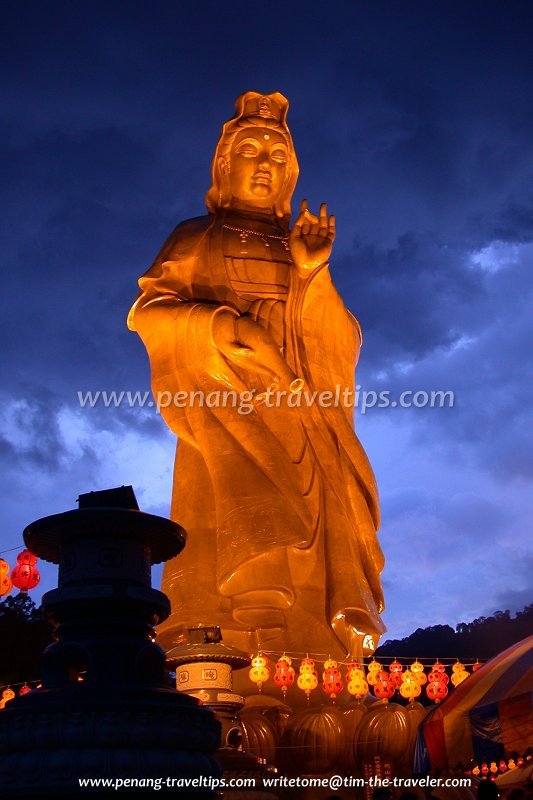 The Kuan Yin Statue of Kek Lok Si, before the pavilion was built to shelter it (2 February 2003)
The Kuan Yin Statue of Kek Lok Si, before the pavilion was built to shelter it (2 February 2003)
Many decades would pass before another star attraction assumes its position at Kek Lok Si Temple, the giant statue of Kuan Yin, the Goddess of Mercy. The 30.2m bronze statue of the Avalokitesvara, as the Kuan Yin is known in Sanskrit, stands on a hillside above the pagoda. It was completed and open to the public at the end of 2002. It is in fact the second giant Kuan Yin statue to be erected. A smaller version was unveiled in the early 1980s. Today only a bust of that first statue remains.
The prime mover in getting the Kuan Yin statue built was the late abbot of Kek Lok Si, the Most Venerable Bai Sheng, who had wanted to build a 120-meter tall statue, but scaled it down to a height limit imposed by the state government under Tan Sri Dr Koh Tsu Koon. Funds from throngs of donors and wealthy benefactors has helped the Kek Lok Si Temple to continue expanding. One of its latest projects is the construction of a pavilion to shelter the giant Kuan Yin statue. The 20-storey pavilion was consecrated on 6 December, 2009, in a ceremony attended by Dr Koh and his successor Lim Guan Eng.
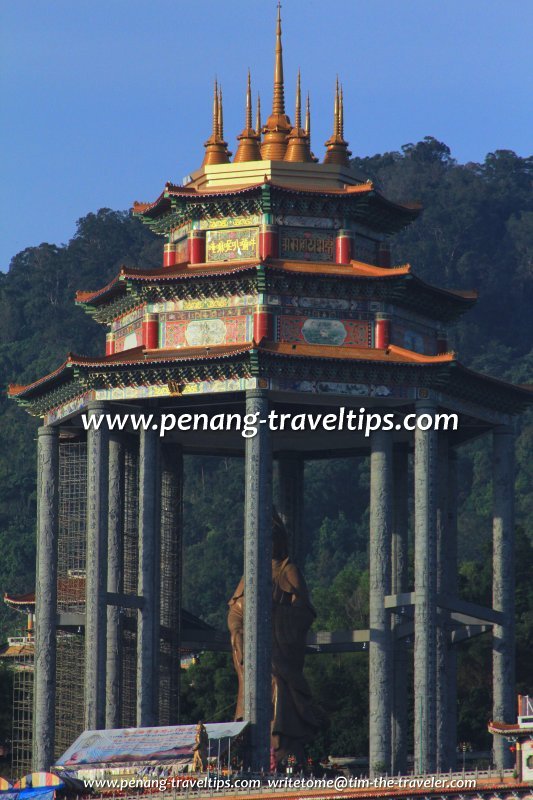 Kuan Yin Pavilion, Kek Lok Si (25 January 2012)
Kuan Yin Pavilion, Kek Lok Si (25 January 2012)
Going to Kek Lok Si Temple
By CarThere is a parking lot at the Lower Tier, at the Middle Tier and at the Upper Tier. Parking fee at the Lower Tier is RM3 for the first 3 hours, while at the Middle Tier and Upper tier, it is RM3 per entry.
Map of Kek Lok Si Temple Car Parks
By Public Bus
Rapid Penang Bus 201, 203, 204, 306 and 502 go to Air Itam Village. The most convenient bus stop is located along Jalan Pasar, at the foot of the temple. Jalan Pasar is a one-way street. Walk following the traffic flow until you reach a T-junction. You can see Kek Lok Si towering on the left side. Turn left and walk in its direction.
Kek Lok Si Temple Visitor Guide
Kek Lok Si Temple is a massive, sprawling complex with numerous shrines and pavilions. I created this visitor guide to ensure that you do not miss out on any of the sights. All the sights are numbered beginning with those at the base and culminating with the sight at the top.Exploring Kek Lok Si Temple
There are several entrances to enter Kek Lok Si. Until 2020, the traditional way to enter the temple complex was by crossing the bridge across Sungai Air Itam, which marks the entrance into Kek Lok Si. This leads to an ascending pathway with stalls selling souvenirs and trinkets on both sides.
This leads to an ascending pathway with stalls selling souvenirs and trinkets on both sides.  As of 2022, this passageway is now no longer passeable, as there is on-going renovations and reconstruction in progress.
As of 2022, this passageway is now no longer passeable, as there is on-going renovations and reconstruction in progress.Along the way up, you pass through the archway of the Kong Min School First Branch.
 Construction of the school building was funded by the philanthropist brothers Aw Boon Haw and Aw Boon Par of Tiger Balm fame. Together, they were instrumental in the building of many schools and temples all across Peninsular Malaya.
Construction of the school building was funded by the philanthropist brothers Aw Boon Haw and Aw Boon Par of Tiger Balm fame. Together, they were instrumental in the building of many schools and temples all across Peninsular Malaya.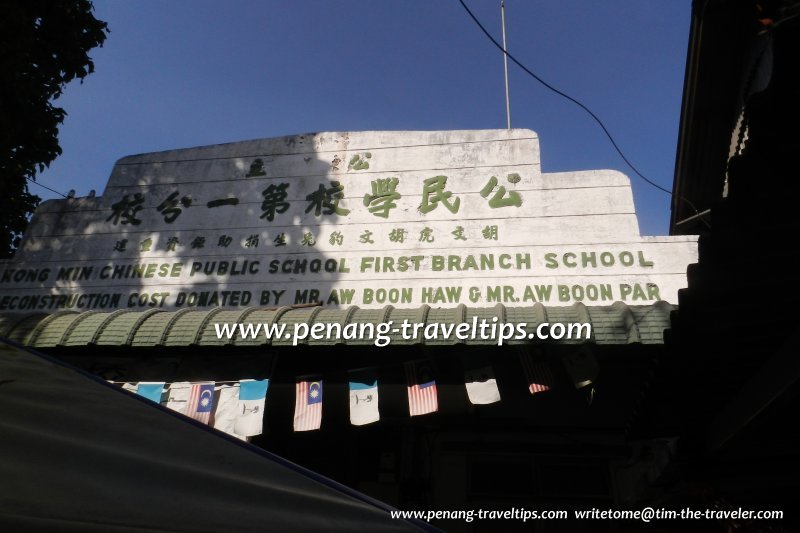 Kong Min School First Branch (25 January 2012)
Kong Min School First Branch (25 January 2012)
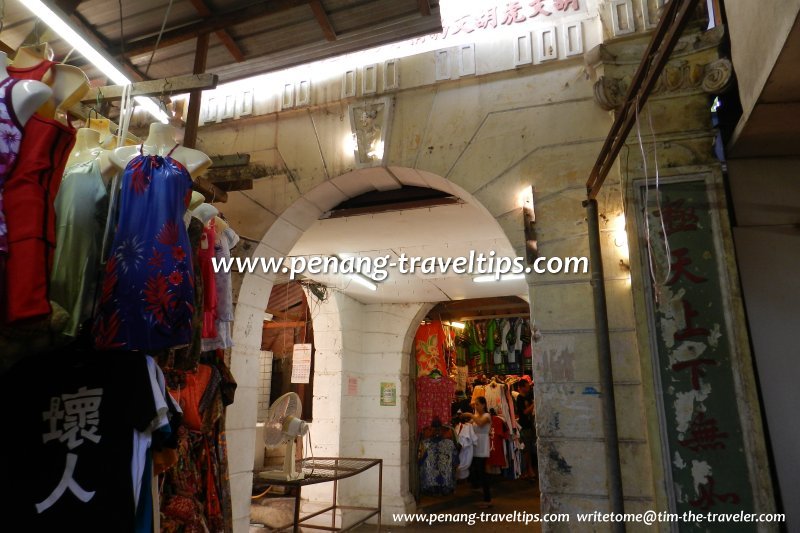 Kong Min School pavilion, in the midst of the souvenir stalls passageway (25 January 2012)
Kong Min School pavilion, in the midst of the souvenir stalls passageway (25 January 2012)
The souvenir passageway leads to the Liberation Pond, also called the Tortoise Pond.
 One of the highlights of Kek Lok Si Temple, the pond holds hundreds of tortoise, many over fifty years old. Vendors sell kangkung (water convolvulus) which you can buy to feed the tortoise. The pond appears murky and unkempt.
One of the highlights of Kek Lok Si Temple, the pond holds hundreds of tortoise, many over fifty years old. Vendors sell kangkung (water convolvulus) which you can buy to feed the tortoise. The pond appears murky and unkempt.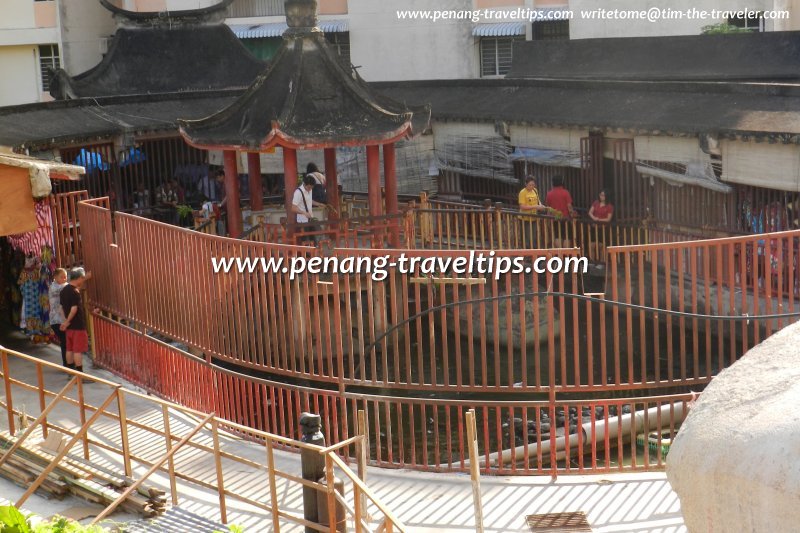 Liberation Pond (Tortoise Pond), Kek Lok Si (25 January 2012)
Liberation Pond (Tortoise Pond), Kek Lok Si (25 January 2012)
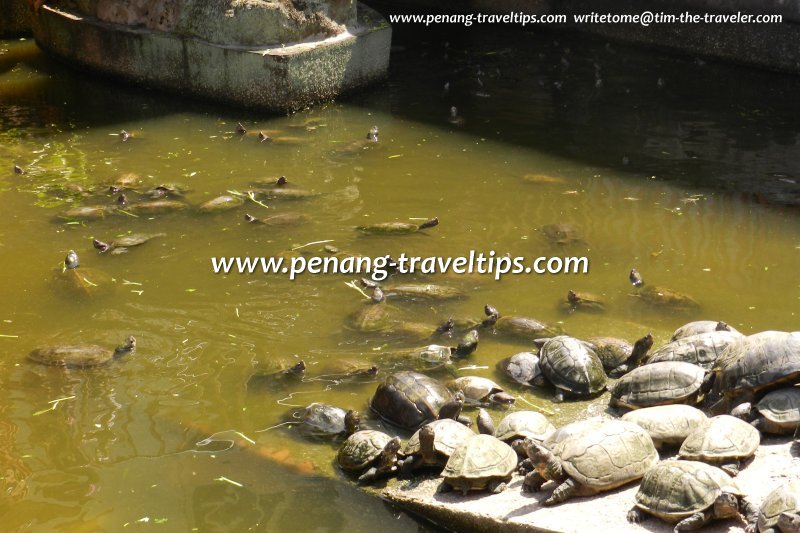 Tortoises in the Liberation Pond at Kek Lok Si (25 January 2012)
Tortoises in the Liberation Pond at Kek Lok Si (25 January 2012)
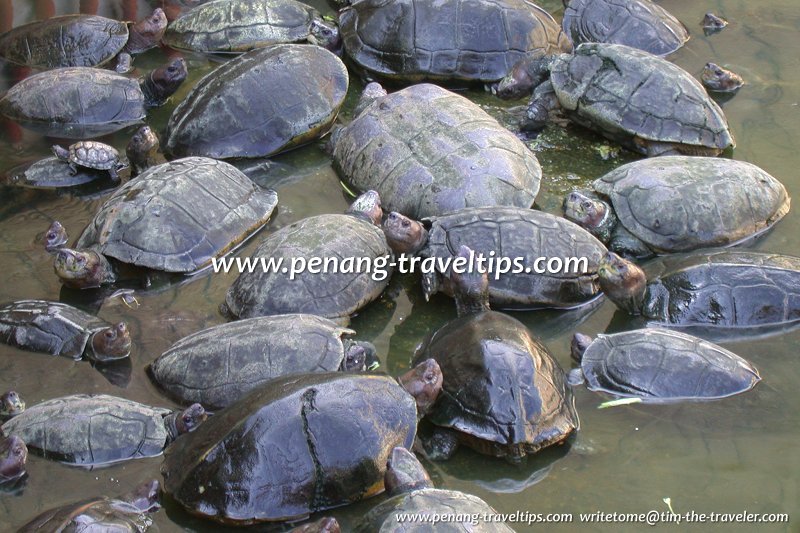 Tortoises at Kek Lok Si (1 February 2003)
Tortoises at Kek Lok Si (1 February 2003)
The pathway continues up to Middle Station, the mid way point in the temple complex. On this level is a large air-conditioned souvenir store, a basement parking lot and an open parking lot. The souvenir store, run by the temple, sells religious paraphernalia. Located right above these is the Middle Station Shrine Hall.
 This is the first of many major halls within the temple complex. It has a double-tier roof with roof ridges that curve upwards. The orange tiles bear the names of donors who contributed to its building fund.
This is the first of many major halls within the temple complex. It has a double-tier roof with roof ridges that curve upwards. The orange tiles bear the names of donors who contributed to its building fund.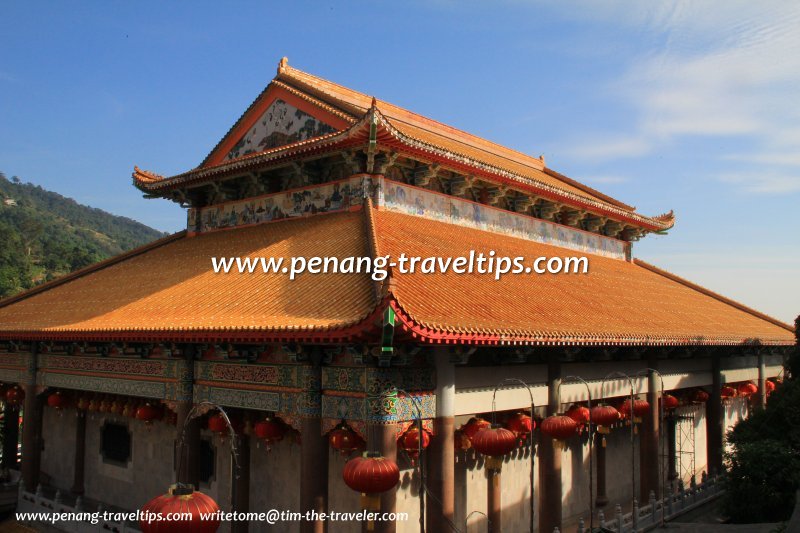 Middle Station Shrine Hall, Kek Lok Si (25 January 2012)
Middle Station Shrine Hall, Kek Lok Si (25 January 2012)
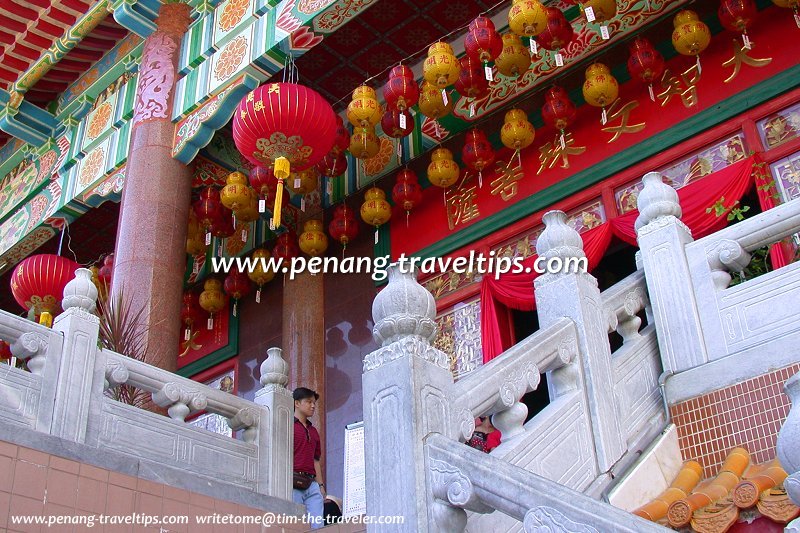 Entrance to the Middle Station Shrine Hall, Kek Lok Si (1 February 2003)
Entrance to the Middle Station Shrine Hall, Kek Lok Si (1 February 2003)
You can drive directly to the Middle Station of Kek Lok Si, entering via the Grand Arch.
 This ornate arch is the main entrance to the Kek Lok Si complex, discounting the lower section with the souvenir stalls.
This ornate arch is the main entrance to the Kek Lok Si complex, discounting the lower section with the souvenir stalls.Stone stairs leads from the car park to the Kek Lok Si Central Court. This is a courtyard that appears like a quadrangle with the other attractions looming up around it. The two main features of the Central Court is the Seven-Tier Pagoda and the Circular Pavilion. Due to the height of the surrounding sights, the Central Court is usually in shadow except during noon time.
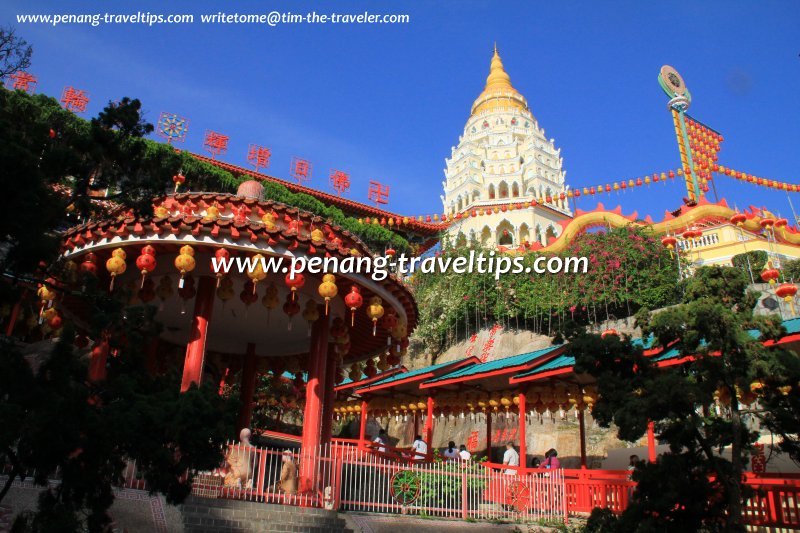 Circular Pavilion, Kek Lok Si (25 January 2012)
Circular Pavilion, Kek Lok Si (25 January 2012)
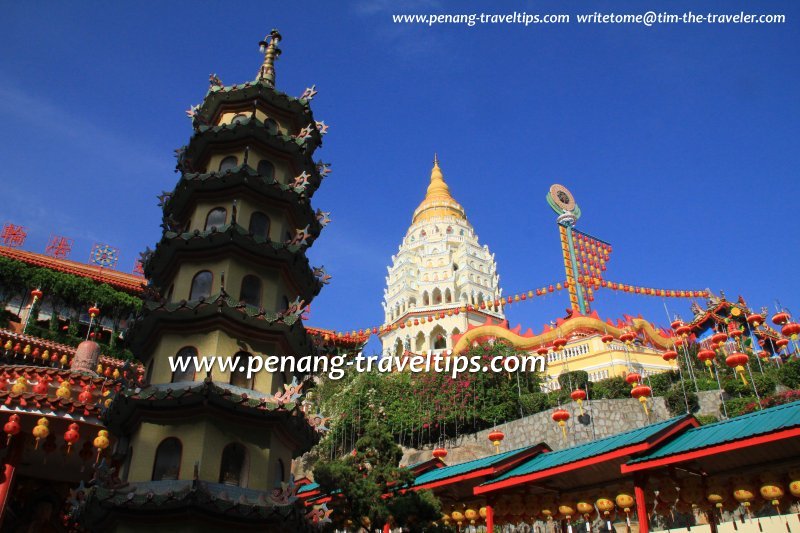 Seven-Tier Pagoda, Kek Lok Si (25 January 2012)
Seven-Tier Pagoda, Kek Lok Si (25 January 2012)
A covered walkway wraps around the side of the Central Court, with steps leading gradually to the Viewpoint.
 This is a good location to get a good view of the Kek Lok Si complex, with the Pagoda of Ten Thousand Buddhas on the left, the Middle Station Shrine Hall on the right and the Central Court down below.
This is a good location to get a good view of the Kek Lok Si complex, with the Pagoda of Ten Thousand Buddhas on the left, the Middle Station Shrine Hall on the right and the Central Court down below.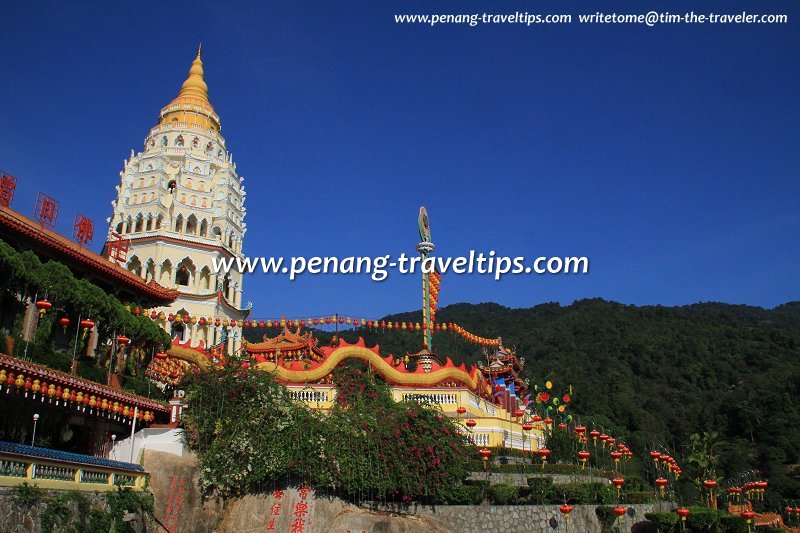 The Pagoda of Ten Thousand Buddhas, as seen from the Viewpoint (25 January 2012)
The Pagoda of Ten Thousand Buddhas, as seen from the Viewpoint (25 January 2012)
From the Viewpoint, enter a gateway. In front of you is a row of stelae (stone tablets) inscribed with details of construction and donors. The path leads to the left, continuing to Three Tier Pagoda
 and the Hall of the Laughing Buddha.
and the Hall of the Laughing Buddha. 
The Three Tier Pagoda is a three-storey building. It is within a courtyard surrounded by the Cloister of Standing Buddhas, an uninterrupted row of standing Buddha images with the right hand pointing down and the left hand bent at elbow.
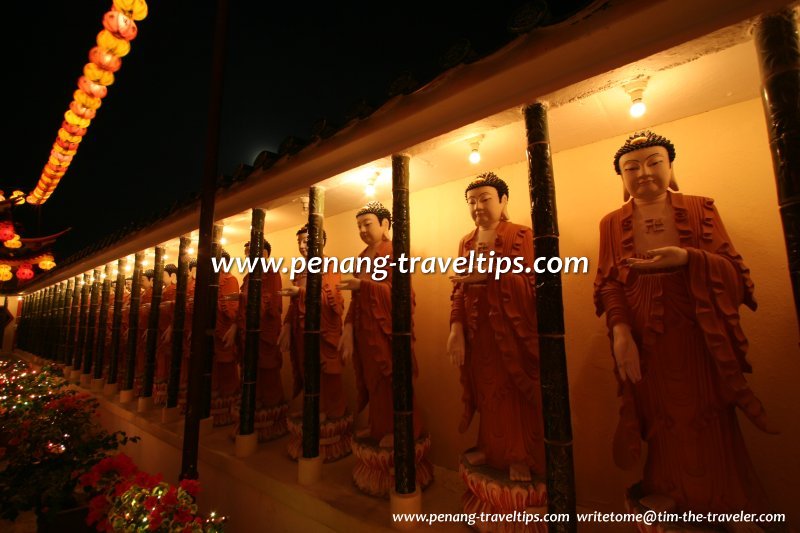 Cloister of Standing Buddhas, Kek Lok Si (9 February 2009)
Cloister of Standing Buddhas, Kek Lok Si (9 February 2009)
Only the first two levels of the Three Tier Pagoda are open to the public. The three seated Buddha images are installed on the second level while on the ground floor is a Thai-style seated Buddha in the earth-touching posture, or Bhumisparsha mudra. It is surrounded by a verandah which offers good views of Kek Lok Si Temple and the cityscape of George Town.
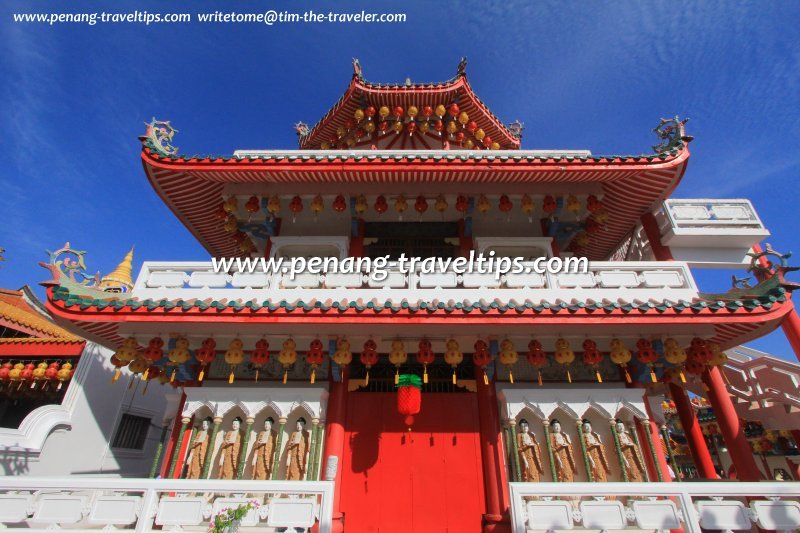 Three Tier Pagoda, Kek Lok Si (25 January 2012)
Three Tier Pagoda, Kek Lok Si (25 January 2012)
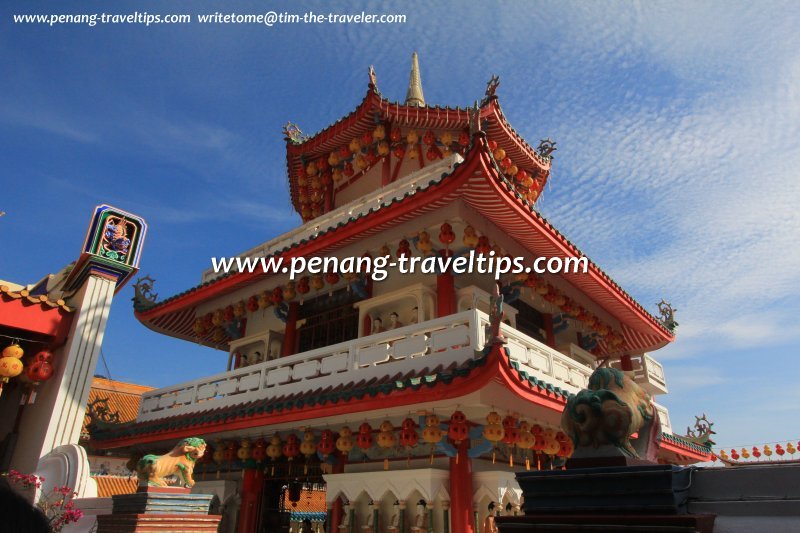 The Three-Tier Pagoda of Kek Lok Si (25 January 2012)
The Three-Tier Pagoda of Kek Lok Si (25 January 2012)
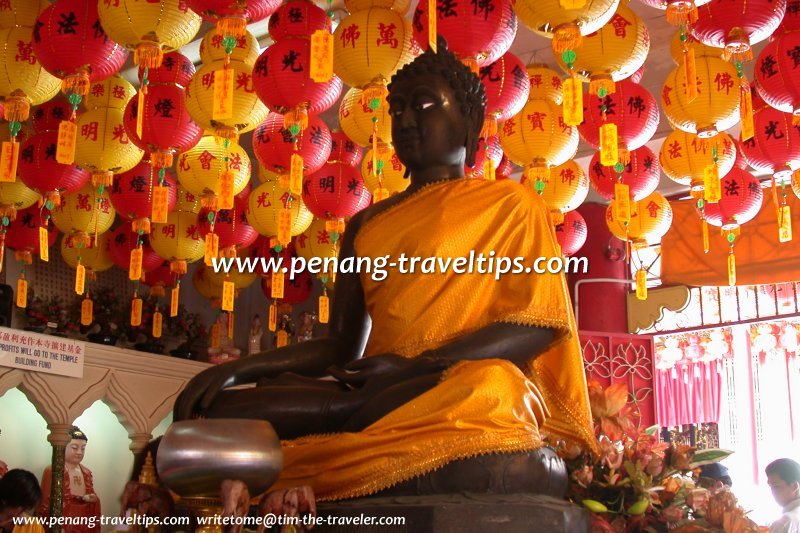 Earth-touching Buddha, ground level of the Three Tier Pagoda, Kek Lok Si (2 February 2003)
Earth-touching Buddha, ground level of the Three Tier Pagoda, Kek Lok Si (2 February 2003)
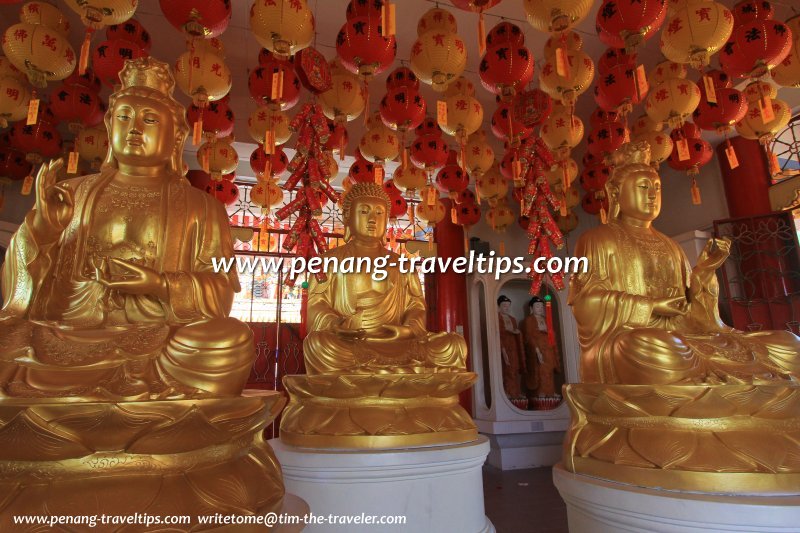 The Three Seated Buddhas, Kek Lok Si (25 January 2012)
The Three Seated Buddhas, Kek Lok Si (25 January 2012)
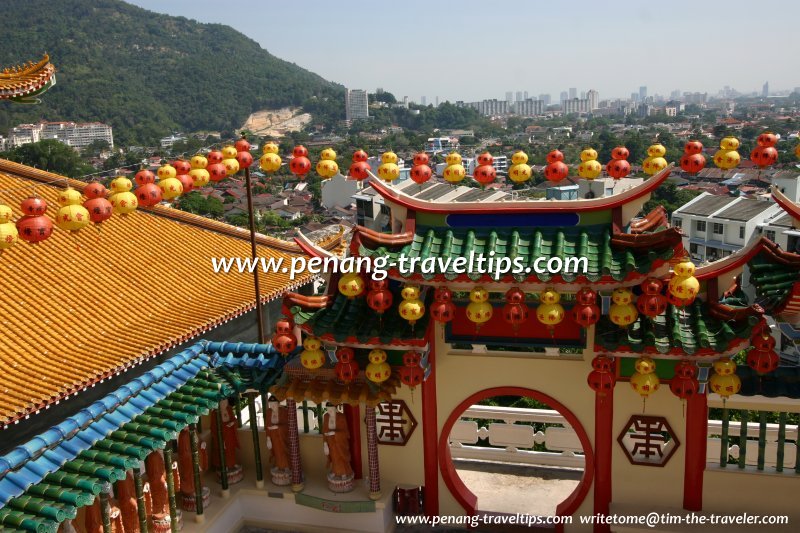 George Town, as seen from the Three Tier Pagoda at Kek Lok Si (28 January 2006)
George Town, as seen from the Three Tier Pagoda at Kek Lok Si (28 January 2006)
Within the courtyard of the Pagoda of the Three Seated Buddhas is a small Shrine to the Four-Faced Buddha, a representation of the Hindu deity Brahma. Beyond it is the Hall of the Laughing Buddha, but just before you enter it, you will see on your left the Shrine of the Horse-headed Kuan Yin (馬頭観音).

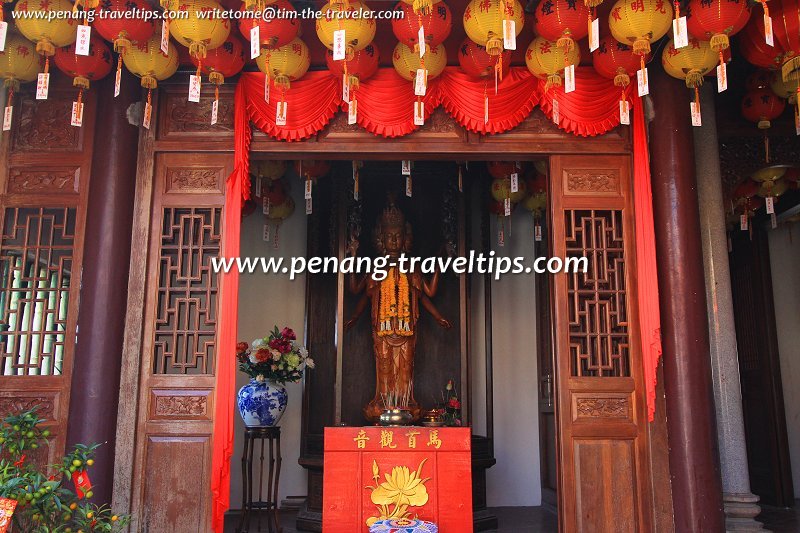 Shrine of the Horse-headed Kuan Yin, Kek Lok Si (25 January 2012)
Shrine of the Horse-headed Kuan Yin, Kek Lok Si (25 January 2012)
Through an ornate wooden gate you enter the Hall of the Laughing Buddha. The Laughing Buddha, known in Chinese as Budai (布袋) is identified as an incarnation of the Maitreya, the future Buddha in Buddhist eschatology. A gargantuan statue of the Laughing Buddha is flanked by guardian sentinels, two on each side. These are known in Chinese as Jīngāng shǒu púsà (金剛手菩薩), Héyíluóhuányuèchā (和夷羅洹閱叉) or Báshéluóbōnì (跋闍羅波膩).
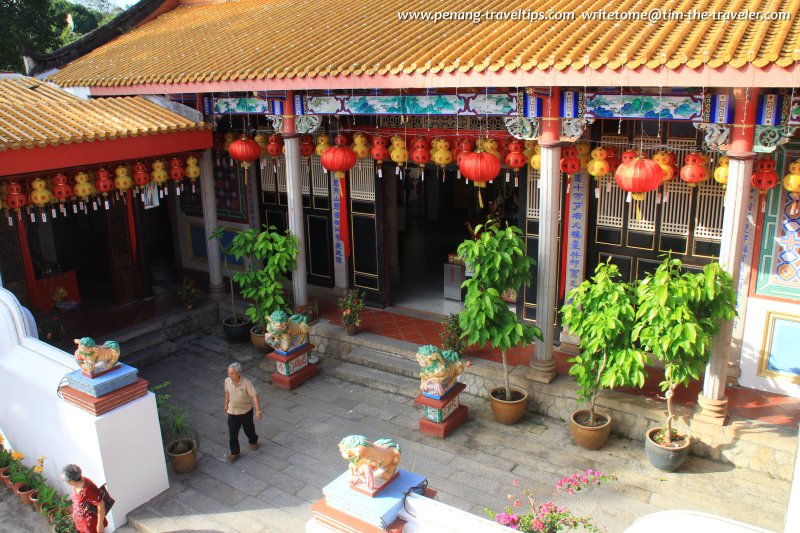 Courtyard in front of the Hall of the Laughing Buddha, with the Shrine of the Horse-headed Kuan Yin to the left (25 January 2012)
Courtyard in front of the Hall of the Laughing Buddha, with the Shrine of the Horse-headed Kuan Yin to the left (25 January 2012)
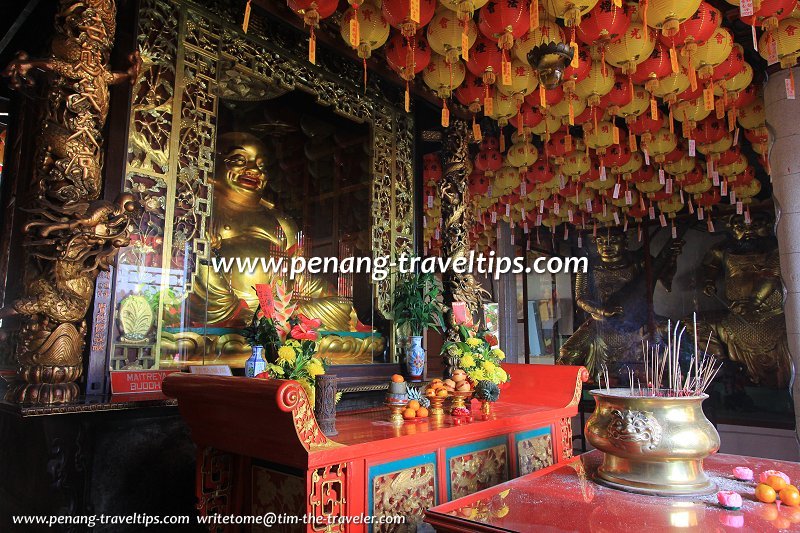 The Maitreya and Guardian Sentinels in the Hall of the Laughing Buddha, Kek Lok Si (25 January 2012)
The Maitreya and Guardian Sentinels in the Hall of the Laughing Buddha, Kek Lok Si (25 January 2012)
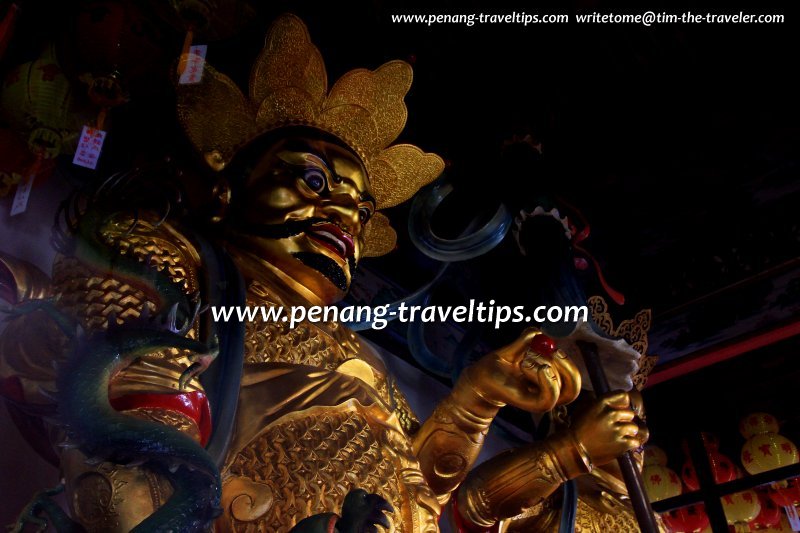 Guardian Sentinels in the Hall of the Laughing Buddha, Kek Lok Si (25 January 2012)
Guardian Sentinels in the Hall of the Laughing Buddha, Kek Lok Si (25 January 2012)
A courtyard separates the Hall of the Laughing Buddha from the Main Prayer Hall.
 The Main Prayer Hall, called Dàxíongbǎo Diàn (大雄宝殿) in Mandarin, is the most important part of the temple complex.
The Main Prayer Hall, called Dàxíongbǎo Diàn (大雄宝殿) in Mandarin, is the most important part of the temple complex.At the Main Prayer Hall you find a plethora of shrines. The place is usually crowded with worshippers, some hanging their prayers on prayer trees. Ribbons of various colours are used for different types of prayers. There are donation box as well as another souvenir kiosk by the side. Devotees making a donation may collect a golden bullion at the base of another Laughing Buddha statue.
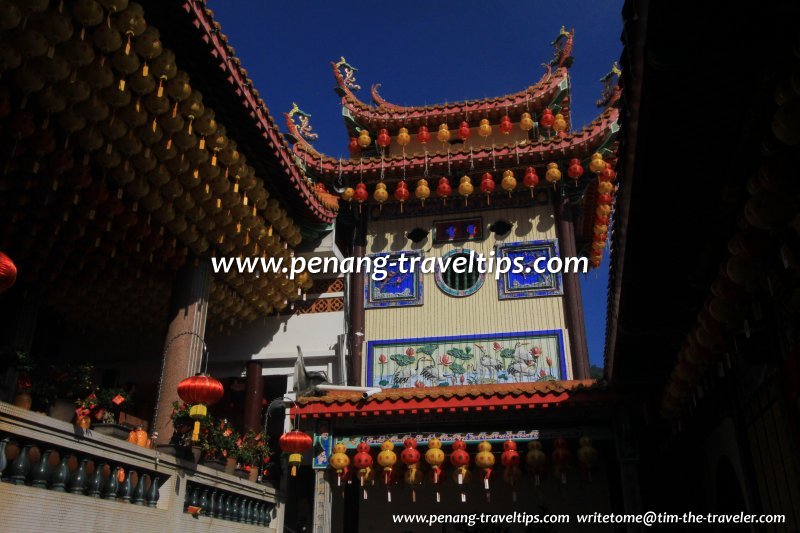 Courtyard between the Hall of the Laughing Buddha and the Main Prayer Hall (25 January 2012)
Courtyard between the Hall of the Laughing Buddha and the Main Prayer Hall (25 January 2012)
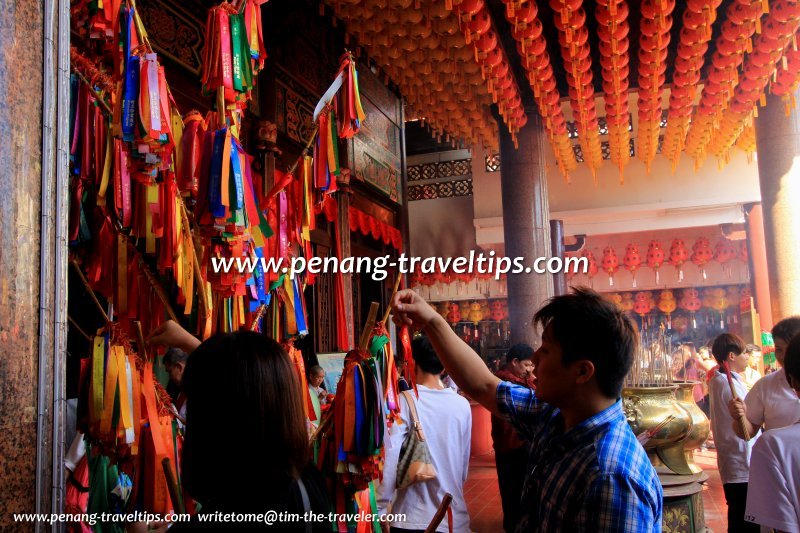 Devotees hanging prayers on the prayer trees (25 January 2012)
Devotees hanging prayers on the prayer trees (25 January 2012)
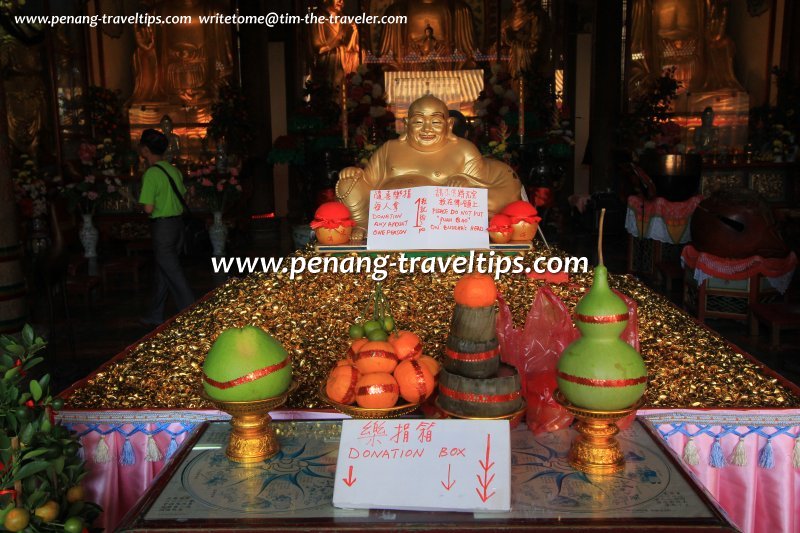 Donation box, Kek Lok Si (25 January 2012)
Donation box, Kek Lok Si (25 January 2012)
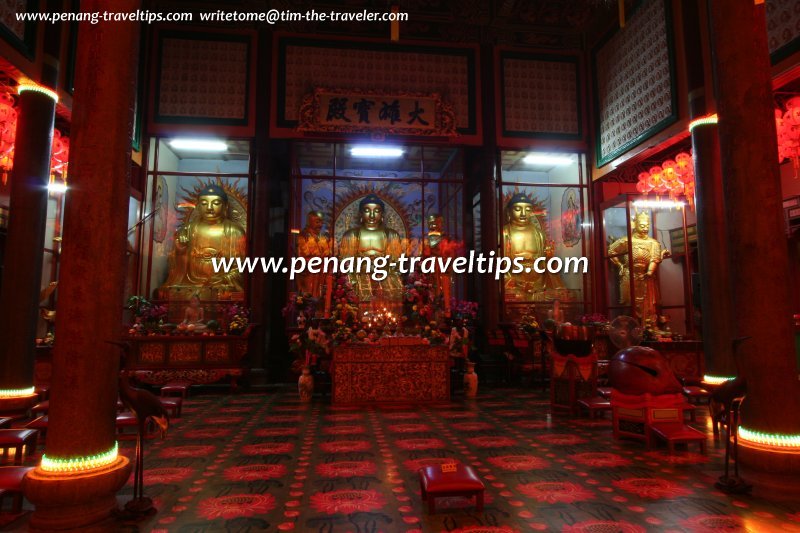 Daxiongbao Dian, the Main Prayer Hall of Kek Lok Si (9 February 2009)
Daxiongbao Dian, the Main Prayer Hall of Kek Lok Si (9 February 2009)
From the Main Prayer Hall, you have the option of taking a right turn, to reach the Pagoda of Ten Thousand Buddhas, or a left turn, to reach the Kuan Yin Pavilion. Let's visit the Pagoda followed by the Pavilion.
On our way to the Pagoda of Ten Thousand Buddhas, we pass by the Grand Hall of Kek Lok Si.
 This is a large assembly hall where Buddhist religious seminars, ordinations and examinations are held.
This is a large assembly hall where Buddhist religious seminars, ordinations and examinations are held.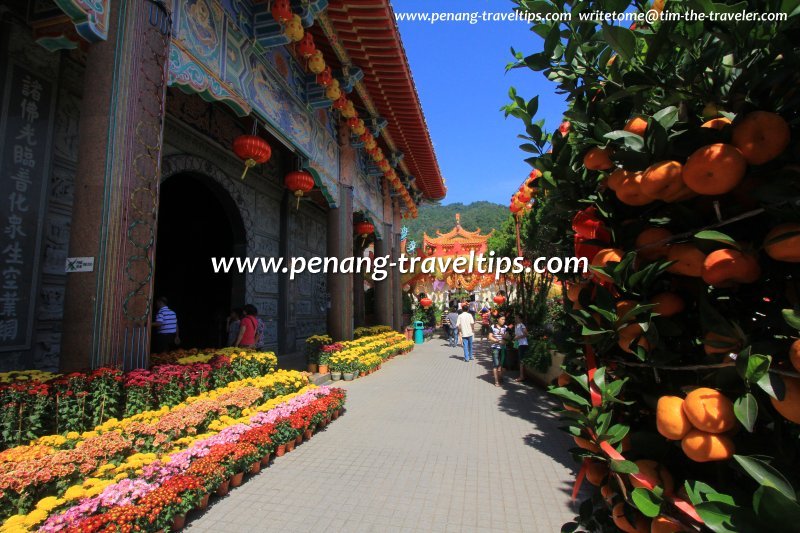 Yard in front of the Grand Hall of Kek Lok Si (25 January 2012)
Yard in front of the Grand Hall of Kek Lok Si (25 January 2012)
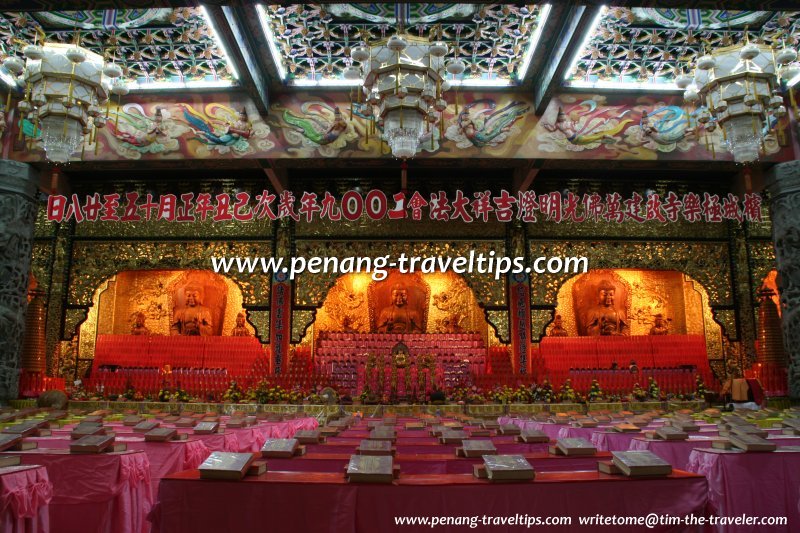 Inside the Grand Hall of Kek Lok Si (9 February 2009)
Inside the Grand Hall of Kek Lok Si (9 February 2009)
From the Grand Hall, we proceed to the Pagoda of Ten Thousand Buddhas. This is the most famous landmark of Kek Lok Si Temple and one of the most recognizable icons of Penang Island. The pagoda has graced countless tourism literature for decades, though lately its position has been challenged (but not entirely eclipsed) by the Kuan Yin Pavilion. Click here to read more about the Pagoda of Ten Thousand Buddhas.

You can climb up the pagoda to view the various architectural styles. The English name of the pagoda is derived from the tiles on the walls depicting Buddha images. Statues of various Buddhas and bodhisattvas grace various levels of the structure.
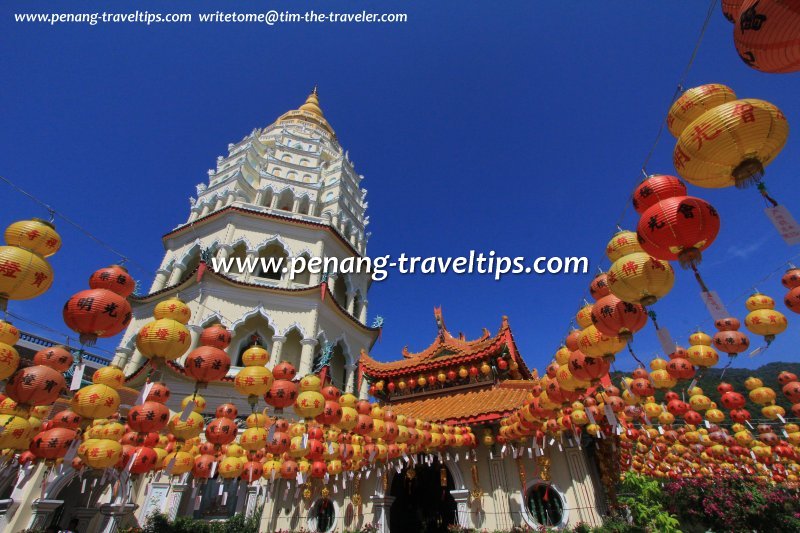 The Pagoda of Ten Thousand Buddhas (25 January 2012)
The Pagoda of Ten Thousand Buddhas (25 January 2012)
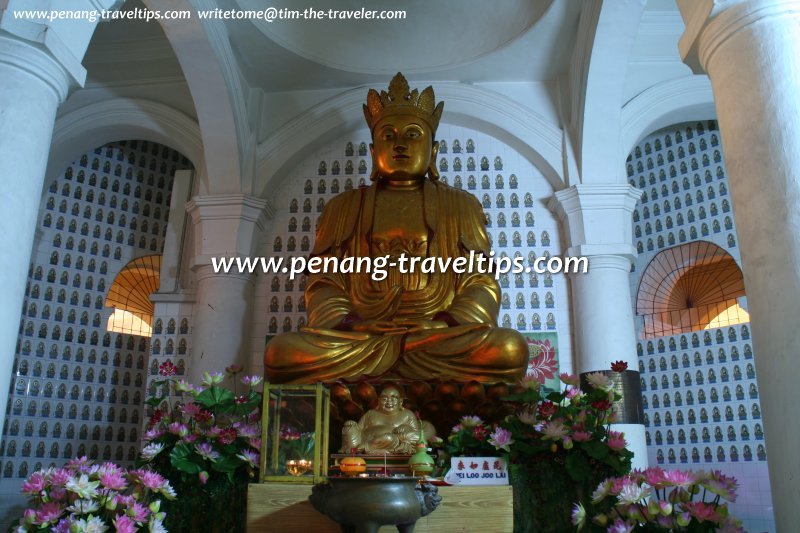 Statues of bodhisattvas within the Pagoda of Ten Thousand Buddhas (9 February 2009)
Statues of bodhisattvas within the Pagoda of Ten Thousand Buddhas (9 February 2009)
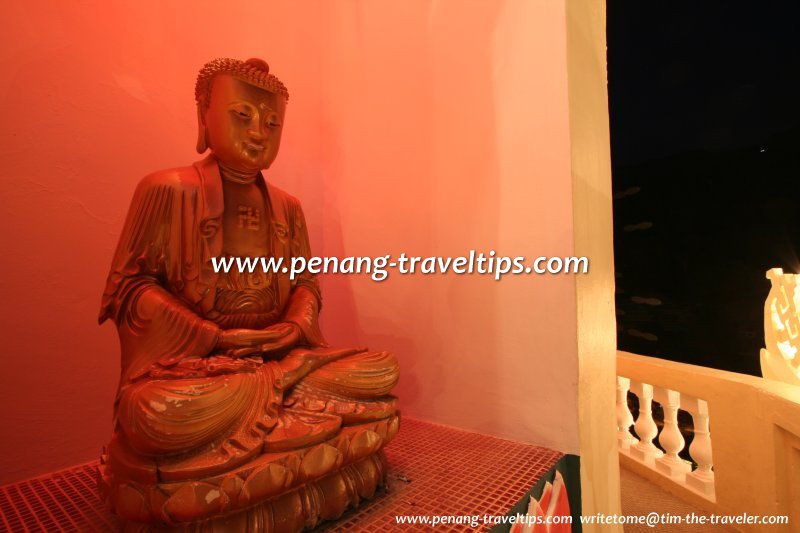 Seated bodhisattva, Pagoda of Ten Thousand Buddhas (9 February 2009)
Seated bodhisattva, Pagoda of Ten Thousand Buddhas (9 February 2009)
At the base of the pagoda is a garden planted with various flowering plants and vegetables.
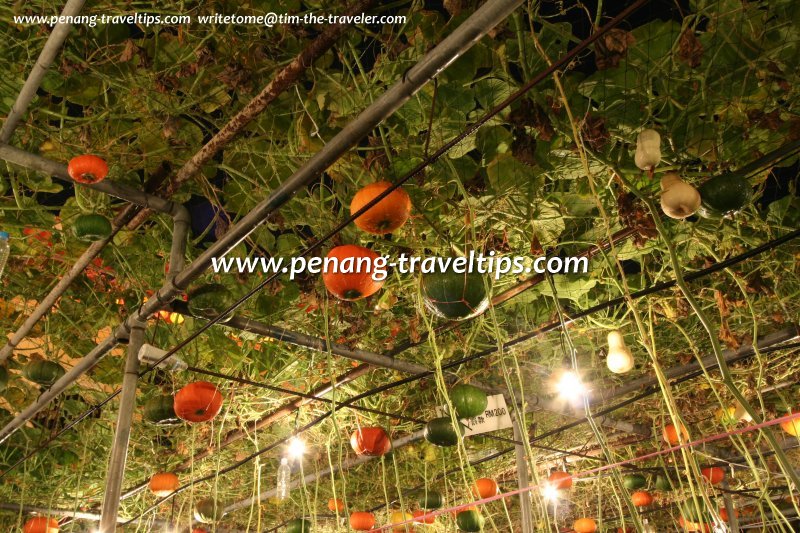 Kek Lok Si Garden (9 February 2009)
Kek Lok Si Garden (9 February 2009)
Next to the garden is a small memorial shrine.
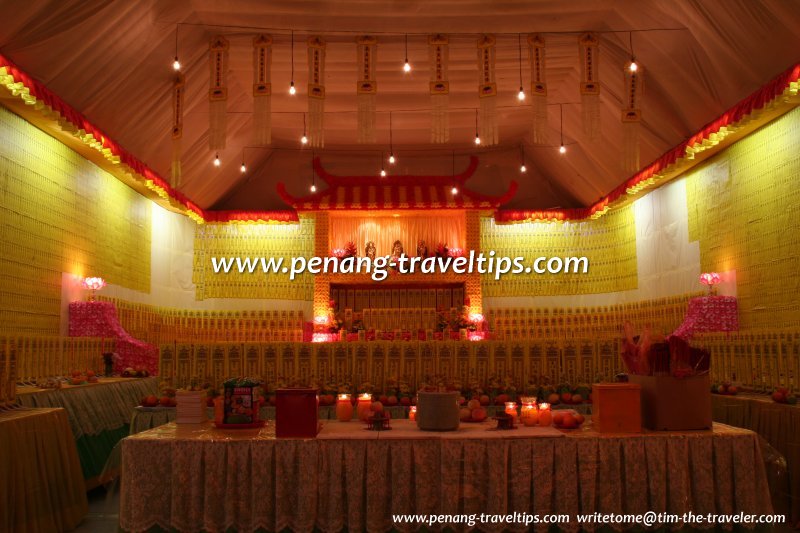 Memorial shrine, Kek Lok Si (9 February 2009)
Memorial shrine, Kek Lok Si (9 February 2009)
Having covered this side of Kek Lok Si Temple, we now return to the Main Prayer Hall and proceed to visit the rest of the temple complex. The left side of the Main Prayer Hall leads to Lower Station of the Inclined Lift.
 At the station there is another big souvenir outlet selling various Buddhist-inspired items.
At the station there is another big souvenir outlet selling various Buddhist-inspired items.You need to purchase the ticket before joining the queue to take the Inclined Lift.
 The fare is RM4 per adult for a return trip.
The fare is RM4 per adult for a return trip.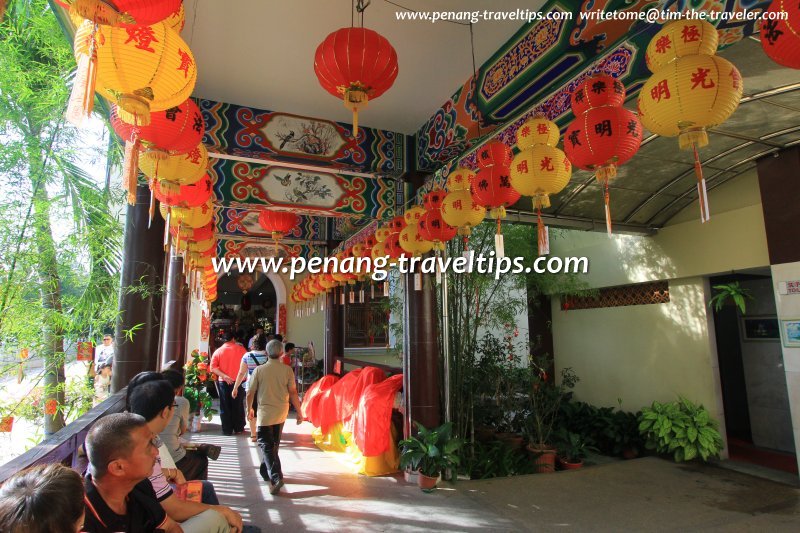 Corridor towards the Inclined Lift Lower Station (25 January 2012)
Corridor towards the Inclined Lift Lower Station (25 January 2012)
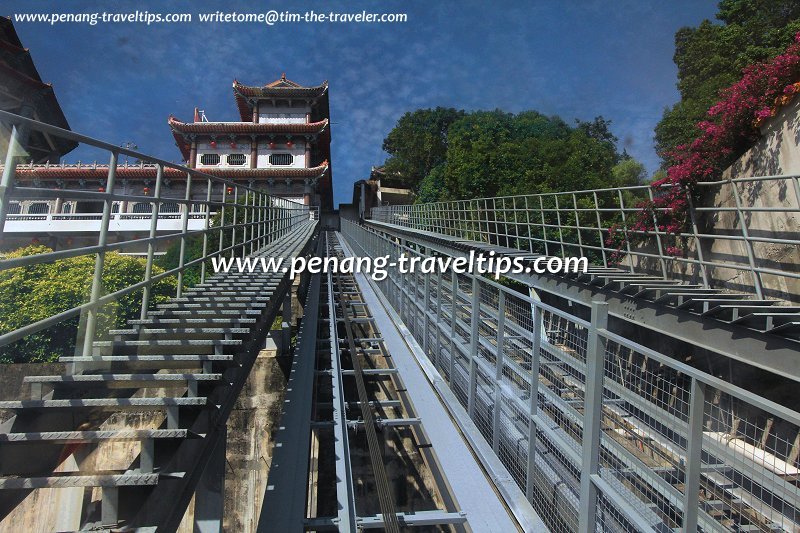 Kek Lok Si Inclined Lift rail (25 January 2012)
Kek Lok Si Inclined Lift rail (25 January 2012)
The Inclined Lift Upper Station
 has a bust of the old Kuan Yin Statue. From here, you enter the Zodiac Garden
has a bust of the old Kuan Yin Statue. From here, you enter the Zodiac Garden  , where you find statues of animals from the Chinese Zodiac.
, where you find statues of animals from the Chinese Zodiac.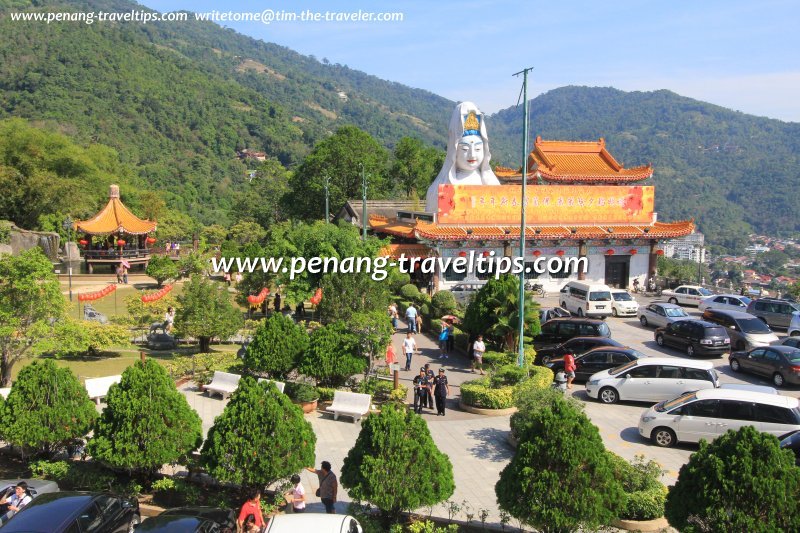 The Inclined Lift Upper Station incorporating the bust of the old Kuan Yin Statue (7 December 2009)
The Inclined Lift Upper Station incorporating the bust of the old Kuan Yin Statue (7 December 2009)
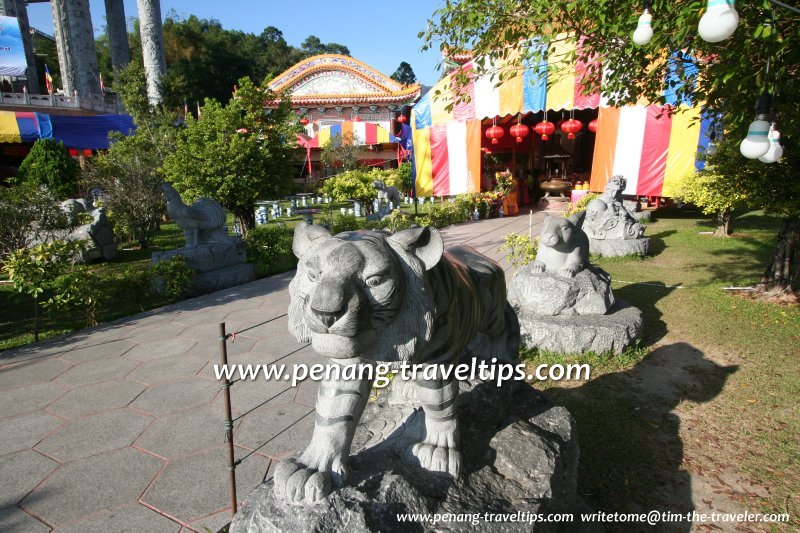 Zodiac Garden, Kek Lok Si Temple (7 December 2009)
Zodiac Garden, Kek Lok Si Temple (7 December 2009)
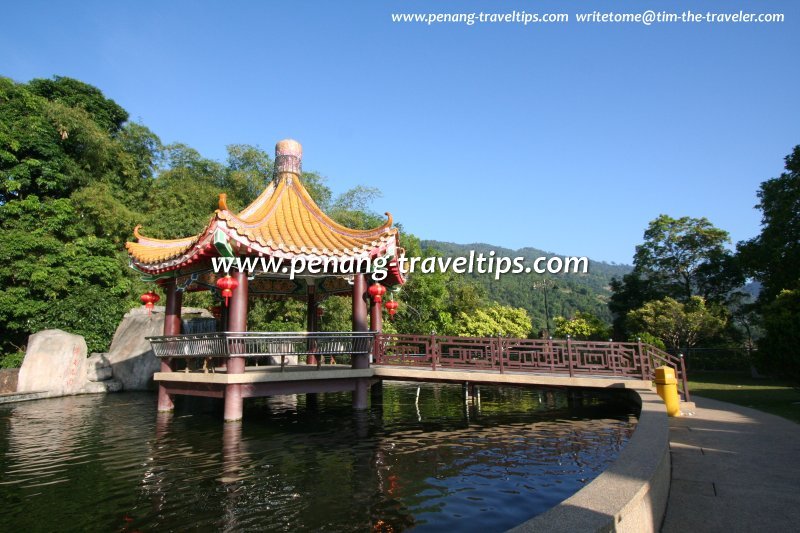 Pavilion and pond at the Zodiac Garden (7 December 2009)
Pavilion and pond at the Zodiac Garden (7 December 2009)
The next attraction is none other than the Kuan Yin Pavilion.
 , which I describe it more detail in its own page.
, which I describe it more detail in its own page.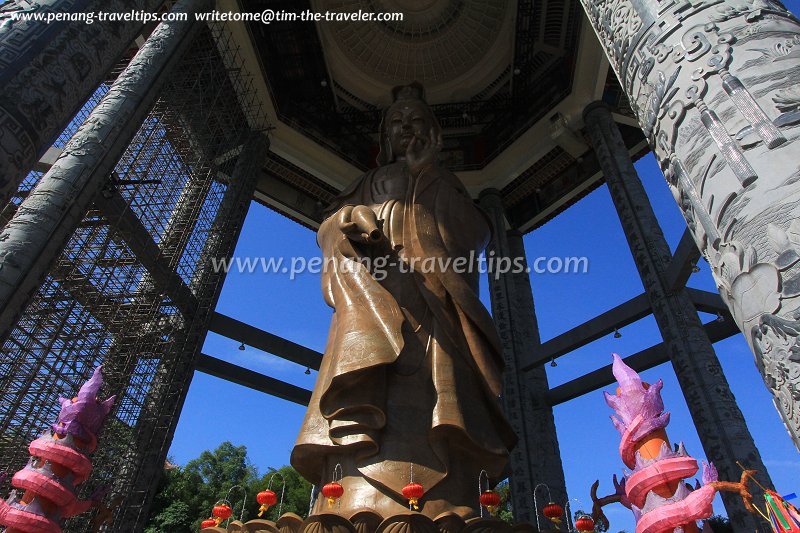 Kuan Yin Pavilion (25 January 2012)
Kuan Yin Pavilion (25 January 2012)
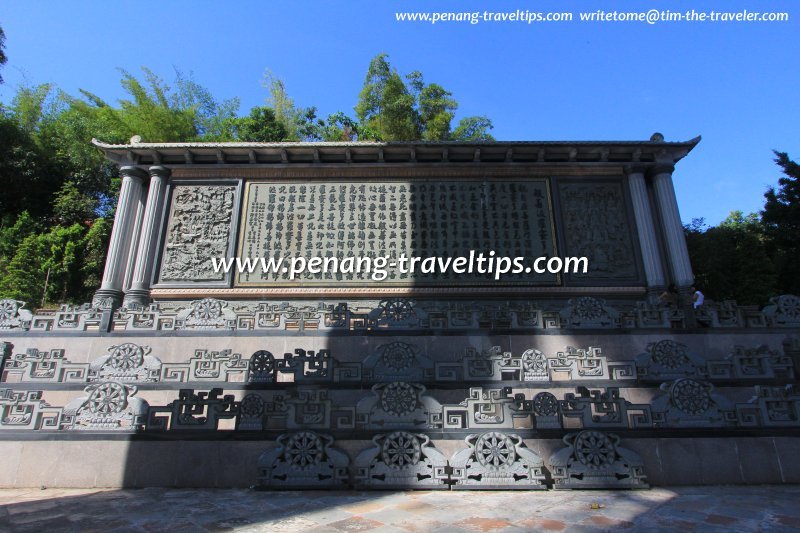 Memorial Tablet at the Kuan Yin Pavilion (25 January 2012)
Memorial Tablet at the Kuan Yin Pavilion (25 January 2012)
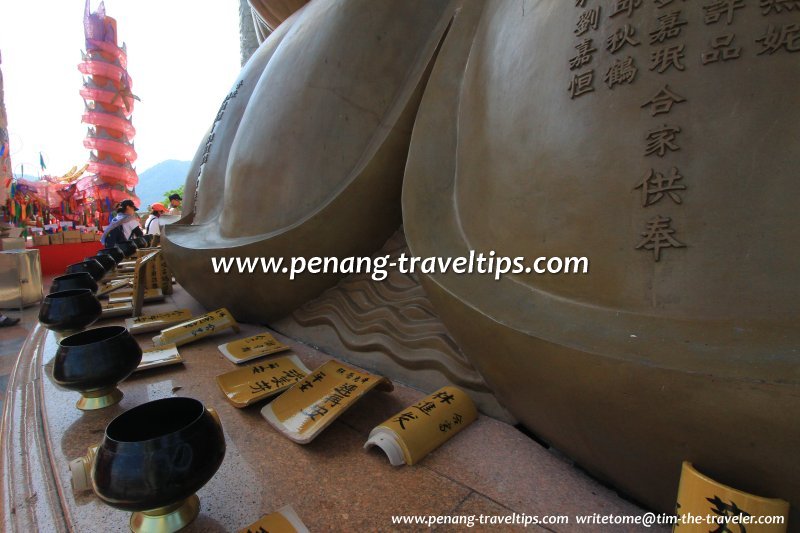 Alms bowls encircle the base of the Kuan Yin pedestal (25 January 2012)
Alms bowls encircle the base of the Kuan Yin pedestal (25 January 2012)
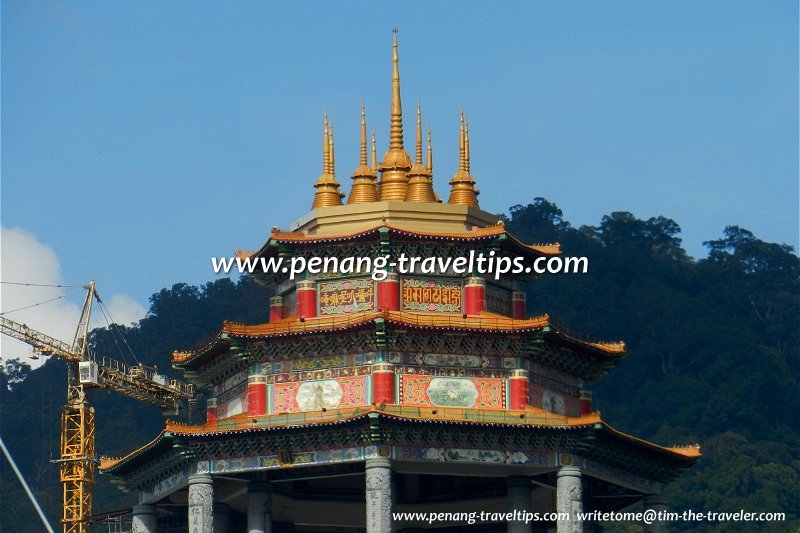 Spire of the Kuan Yin Pavilion (4 June 2011)
Spire of the Kuan Yin Pavilion (4 June 2011)
The last sight to visit is the Kek Lok Si Columbarium.
 Four-storey structure to house the remains of the departed. It is located a short distance from the Kuan Yin Statue, on the road towards the Cheng Kon Sze Temple.
Four-storey structure to house the remains of the departed. It is located a short distance from the Kuan Yin Statue, on the road towards the Cheng Kon Sze Temple.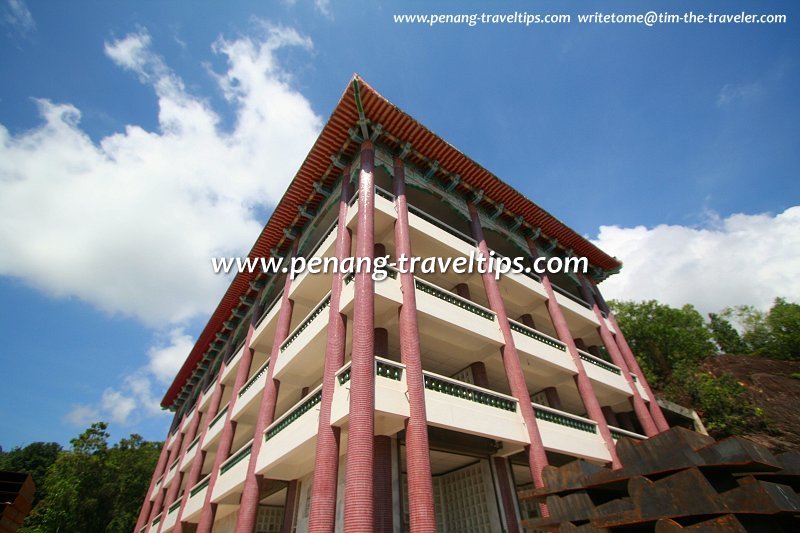 Kek Lok Si Columbarium (11 October 2008)
Kek Lok Si Columbarium (11 October 2008)
Kek Lok Si FAQ
How long does it take to walk from the foot of the hill to the temple proper?If you intend to stop at the shops, coffee shops, tortoise ponds, you may take 40 minutes or so. A relatively fit person can climb straight to the top in 10 minutes. You can also drive to the parking lot at the temple entrance, bypassing the shops.
Above the souvenir shop, the temple proper begins. There is a round pond with a seven-tier ornamental pagoda. It is located in a square above the main Pagoda of 10,000 Buddhas. A sheltered passageway leads up a flight of steps to the Chamber of Seated Buddhas. This two-storey pavilion is cloistered by rows of standing Buddha images. The seated Buddhas are surrounded by lit candles in the form of open lotus.
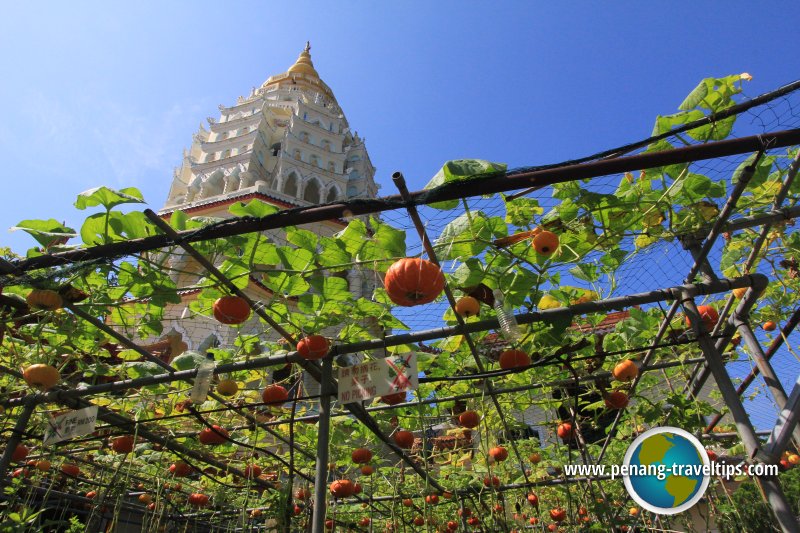 Pumpkin garden at Kek Lok Si (25 January 2012)
Pumpkin garden at Kek Lok Si (25 January 2012)
When's the best time to visit Kek Lok Si Temple?
The best season to visit Kek Lok Si is during the Chinese New Year season, when the temple complex is lit up with thousands of lanterns. It is also the best time to visit the temple complex during the day, as the chances of viewing it against a blue sky is higher. The complex is particularly impressive during dusk, as the lanterns are lit up over a darkening sky. You will see throngs of photography buffs jostling with devotees and worshippers to get the best angle and view, particularly during the blue hour.Kek Lok Si Temple is  on the Map of Ayer Itam, Penang and
on the Map of Ayer Itam, Penang and  on the Map of Air Itam Village
on the Map of Air Itam Village
Related Pages
- Beautiful Kek Lok Si Temple
Photos of Kek Lok Si Temple taken during Chinese New Year 2012. - Kuan Yin Pavilion
The latest addition to the Kek Lok Si temple complex.
Updates
3 June, 2011: The murky Liberation Pond of Kek Lok Si Temple has been criticised by the Penang Society for the Prevention of Cruelty to Animals (SPCA), saying "the tortoises are living in horrendous conditions," according to honorary sectetary Dr. G.S. Gill. Temple trustee Datuk Steven Ooi said they were aware of the overcrowding, and that some tortoises would be relocated to a bigger pond when it is completed in 2012.6 December, 2009
The latest attraction at the Kek Lok Si Temple complex is the Goddess of Mercy Pavilion, consecrated on 6 December, 2009, in the presence of the Chief Minister of Penang, Rt. Hon. Lim Guan Eng, and former Chief Minister of Penang, Tan Sri Dr Koh Tsu Koon.
List of Chinese Temples in Penang and Chinese Temples in Malaysia and Penang Tourist Attractions
Private Guided Tours of Penang
If you are seeking private guided tours of Penang, message Penang Tour Guides at penangtourguides@gmail.com and enquire with them. Buy, rent or sell properties in Penang
Buy, rent or sell properties in Penang
Do you have a property for sale or to rent out? Are you looking to buy or rent a property? Get in touch with me. WhatsApp me (Timothy Tye) at 012 429 9844, and I will assign one of my property agents to serve you. I will choose the agent for you, according to your property needs. So when you message me, provide me some details of what you need, whether to sell, to buy, to rent or to rent out, and what type of property, is it condo, apartment, house, shop, office or land.Adakah anda mempunyai hartanah untuk dijual atau disewakan? Adakah anda ingin membeli atau menyewa hartanah? Hubungi saya. WhatsApp saya (Timothy Tye) di 012 429 9844, dan saya akan menugaskan salah seorang ejen hartanah saya untuk berkhidmat kepada anda. Saya akan pilih ejen untuk anda, mengikut keperluan hartanah anda. Oleh itu, apabila anda menghantar mesej kepada saya, berikan saya beberapa butiran tentang apa yang anda perlukan, sama ada untuk menjual, untuk membeli, untuk disewakan atau untuk disewakan, dan jenis hartanah apakah itu kondo, pangsapuri, rumah, kedai, pejabat atau tanah.
您有待出售或出租的房产吗? 您想购买或租赁房产吗? 与我联系。 WhatsApp 我 (Timothy Tye) 012 429 9844,我将指派一名房地产经纪人为您服务。 我会根据您的房产需求,为您选择代理。 因此,当您给我发消息时,请向我提供一些您需要的详细信息,无论是出售、购买、出租还是出租,以及房产类型,是公寓、公寓、房屋、商店、办公室还是土地。
 New Properties in Penang
New Properties in Penang
Looking to buy property in Penang? Get the e-brochures right here without having to visit or contact individual developers.- Anggun Residences E-Brochure, Batu Kawan
- Aston Acacia E-Brochure, Bukit Mertajam
- Beacon Executive Suites E-Brochure, George Town
- Beverly Heights @ Bukit Gambir E-Brochure, Gelugor
- BM Highland E-Brochure, Bukit Mertajam
- Cypress Villa E-Brochure, Sungai Ara
- D'Zone Condominium E-Brochure, Teluk Kumbar
- Elements Garden E-Brochure, Butterworth
- Ferringhi Residence 2 E-Brochure, Batu Ferringhi
- GEM Residences E-Brochure, Prai
- Golden Triangle 2 E-Brochure, Sungai Ara/Relau
- Grace Residence E-Brochure, Jelutong
- Granito @ Permai E-Brochure, Tanjong Bungah
- Green City Residence E-Brochure, Jelutong
- Havana Beach Residences E-Brochure, Bayan Lepas
- Imperial Residences E-Brochure, Sungai Ara/Relau
- Imperial Grande E-Brochure, Sungai Ara/Relau
- Lucerne Residence E-Brochure, Bayan Lepas
- Mezzo @ The Light City E-Brochure, Gelugor
- Middleton E-Brochure, Gelugor
- Orchard Villa 3 E-Brochure, Simpang Ampat
- Primero Heights E-Brochure, Permatang Pauh
- Queens Waterfront Q2 E-Brochure, Bayan Lepas
- Royale Heights @ Tambun Royale City E-Brochure, Simpang Ampat
- Royale Infinity @ Tambun Royale City E-Brochure, Simpang Ampat
- Rubica @ Harbour Place E-Brochure, Butterworth
- Sensasi Commercial Suites E-Brochure, Batu Kawan
- Setia Sky Ville E-Brochure, Jelutong
- Setia Sky Vista E-Brochure, Sungai Ara/Relau
- Setia V Residence E-Brochure, Gurney Drive
- Sinaran Residence E-Brochure, Batu Kawan
- Sky @ TriPark E-Brochure, Bukit Mertajam
- Skyridge Garden E-Brochure, Tanjong Tokong
- Starhill Luxury Residences E-Brochure, Gelugor
- Straits Residences E-Brochure, Tanjong Tokong
- Taman Nuri Emas E-Brochure, Nibong Tebal
- The Light Collection IV E-Brochure, Gelugor
- The Loft @ Southbay E-Brochure, Batu Maung
- The Terraces Condominium E-Brochure, Bukit Jambul
- Trehaus Condo Villas E-Brochure, Bukit Jambul
- Triuni Residences E-Brochure, Batu Uban
- Urban Suites E-Brochure, Tanjong Tokong
- Valencia Residence E-Brochure, Bayan Lepas
- Vertu Resort E-Brochure, Batu Kawan
- Vivo Executive Apartment E-Brochure, Batu Kawan
- Viluxe E-Brochure, Batu Kawan
- Waterside Residence E-Brochure, Gelugor
 Latest updates on Penang Travel Tips
Latest updates on Penang Travel Tips
 Share your travels and/or ask a travel-related question
Share your travels and/or ask a travel-related question
Join the Penang Travel Tips Facebook Group to share photos, tips and anything related to your travels, or ask travel-related questions.
 Map of Roads in Penang
Map of Roads in Penang
Looking for information on Penang? Use this Map of Roads in Penang to zoom in on information about Penang, brought to you road by road. Discover with Timothy
Discover with Timothy
Let me take you to explore and discover Penang through my series of walking tours on YouTube. You may use these videos as your virtual tour guide. At the beginning of each video, I provide the starting point coordinates which you may key into your GPS, Google Maps or Waze, to be navigated to where I start the walk, and use the video as your virtual tour guide.Disclaimer
Please use the information on this page as guidance only. The author endeavours to update the information on this page from time to time, but regrets any inaccuracies if there be any.Songs about Penang
About this website

Hello and thanks for reading this page. My name is Timothy and my hobby is in describing places so that I can share the information with the general public. My website has become the go to site for a lot of people including students, teachers, journalists, etc. whenever they seek information on places, particularly those in Malaysia and Singapore. I have been doing this since 5 January 2003, for over twenty years already. You can read about me at Discover Timothy. By now I have compiled information on thousands of places, mostly in Peninsular Malaysia and Singapore, and I continue to add more almost every day. My goal is to describe every street in every town in Malaysia and Singapore.
Copyright © 2003-2024 Timothy Tye. All Rights Reserved.